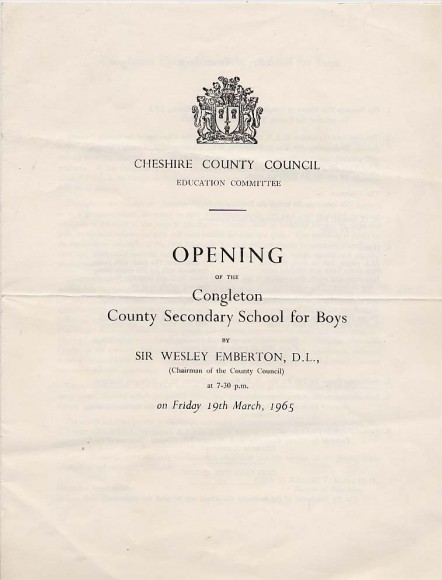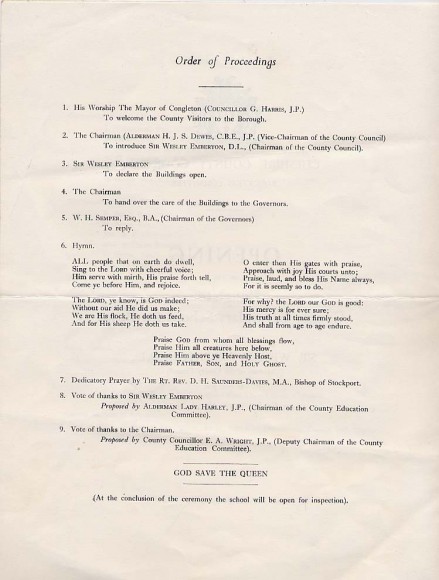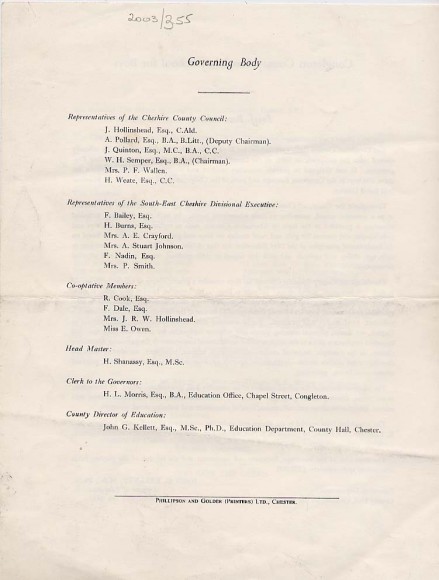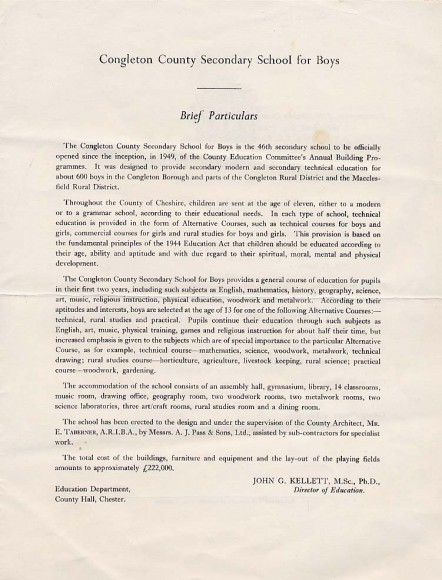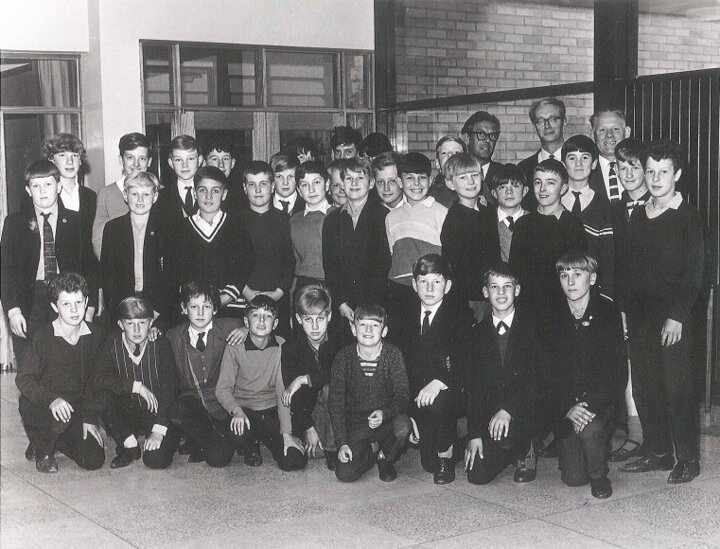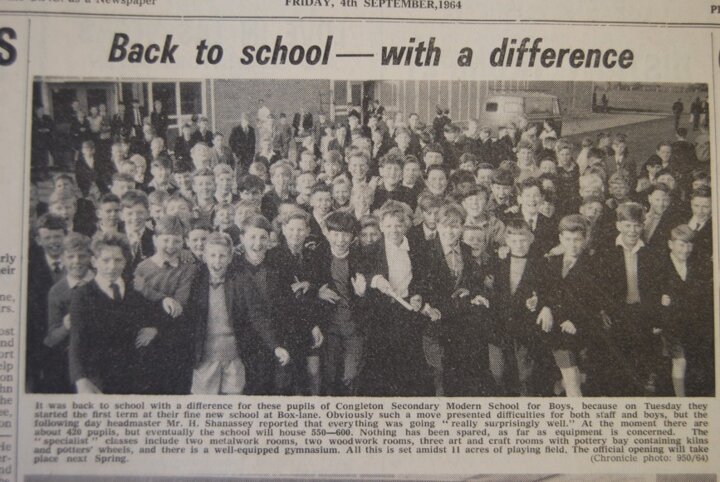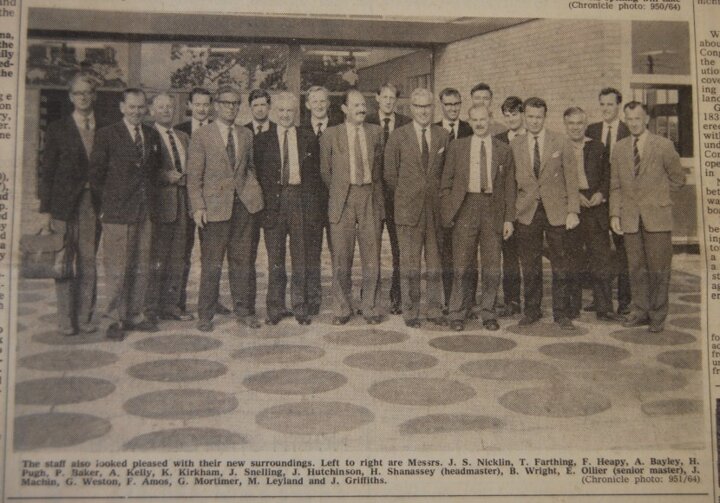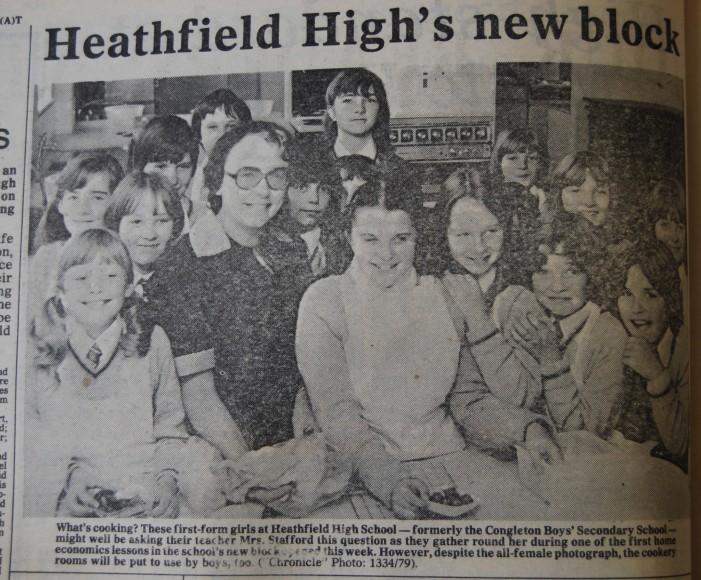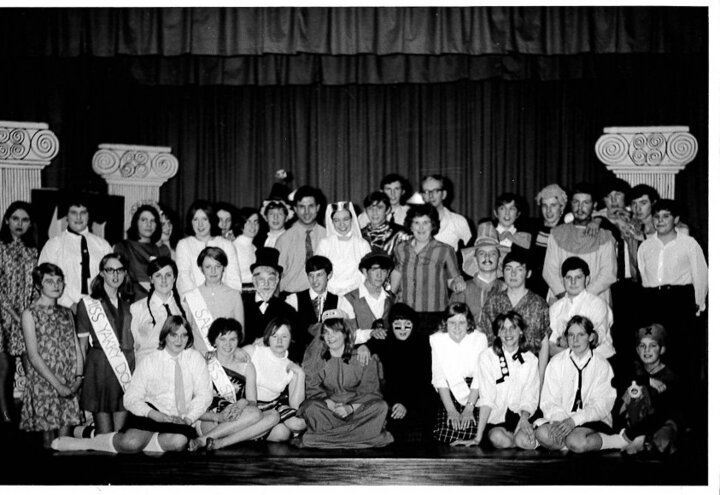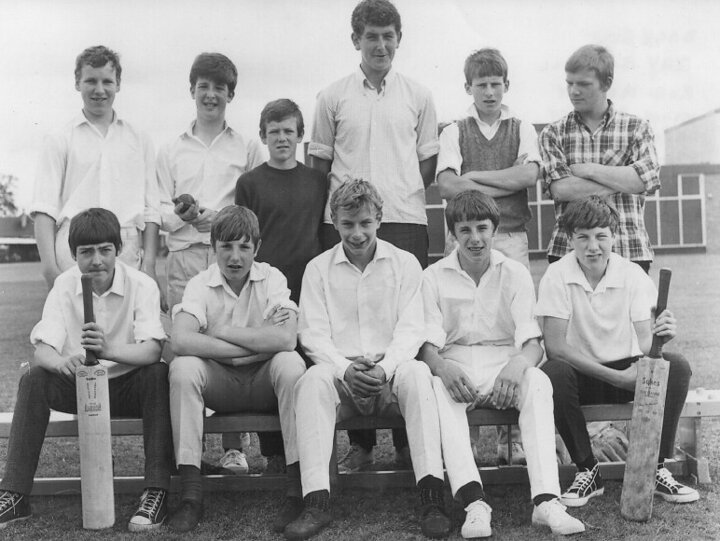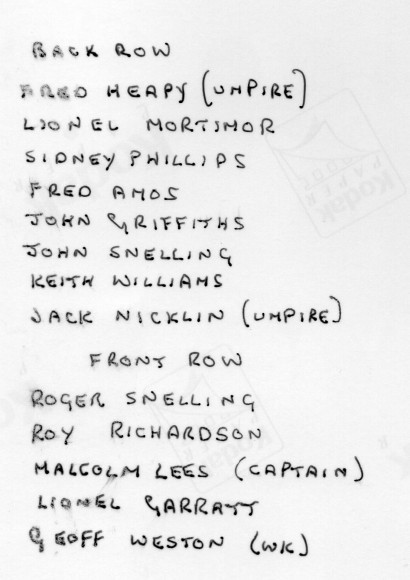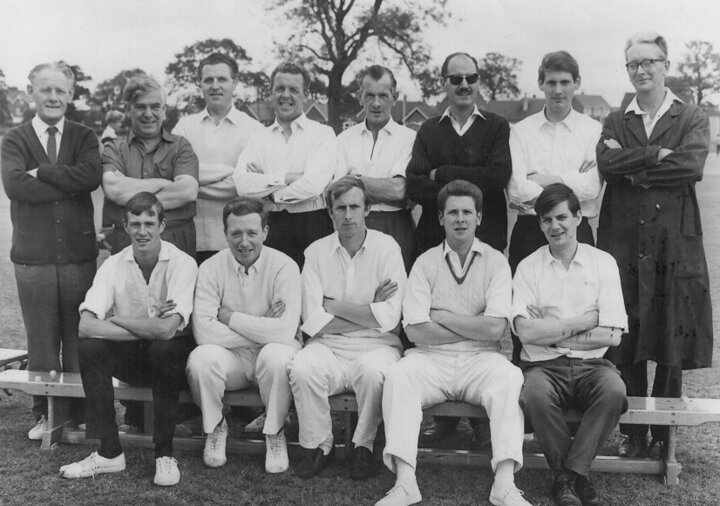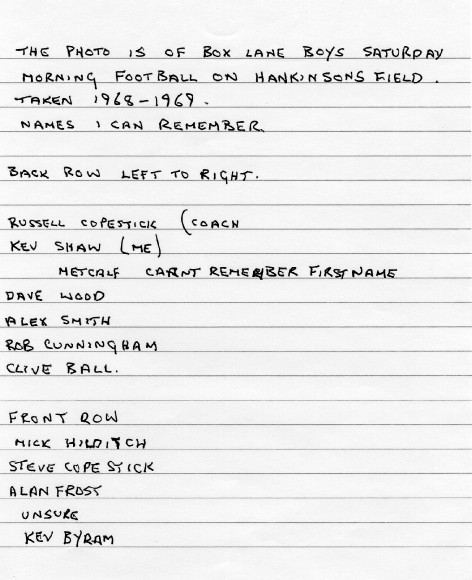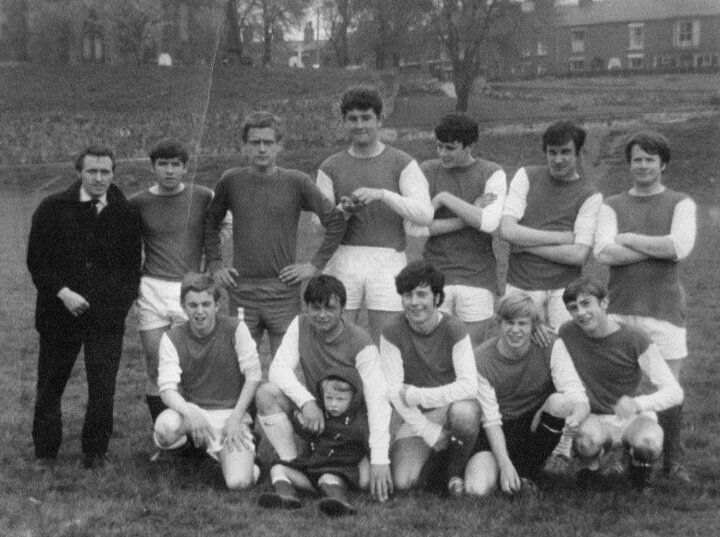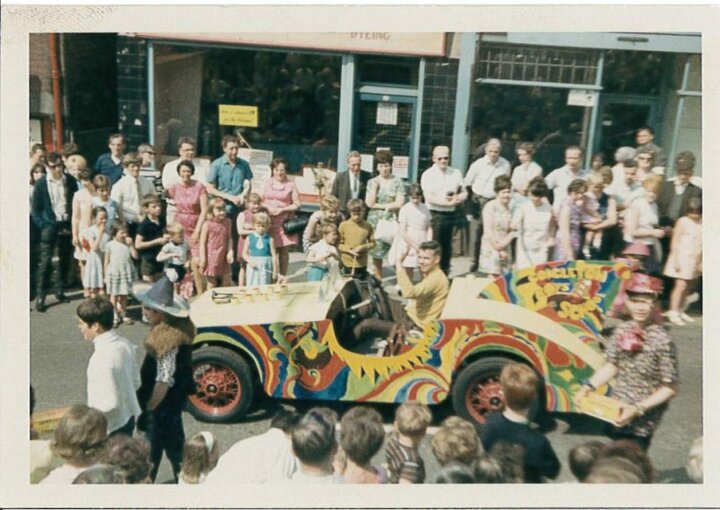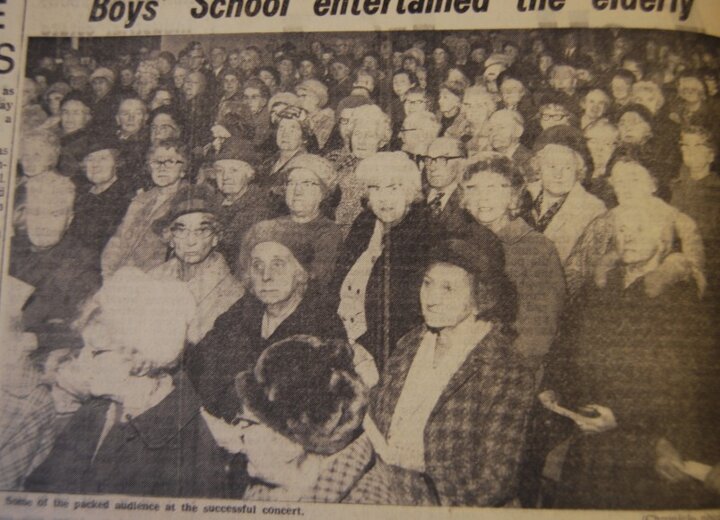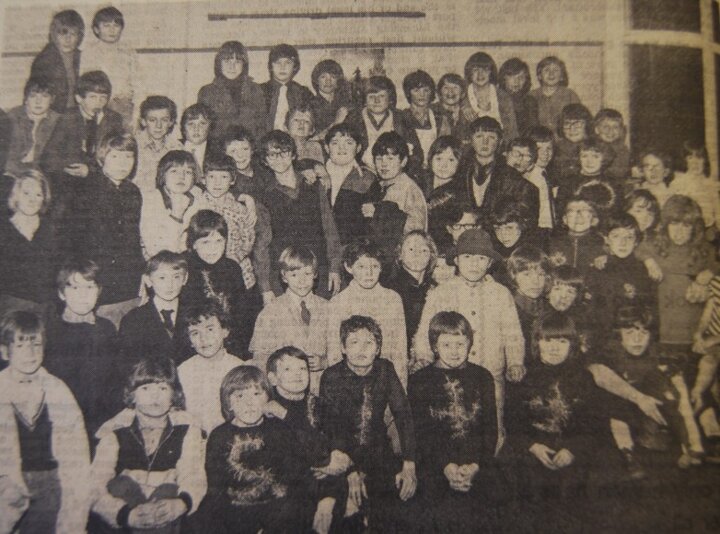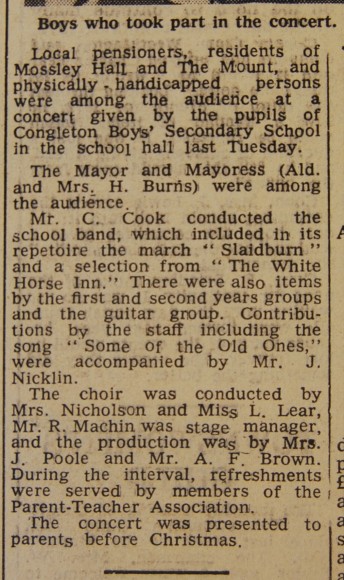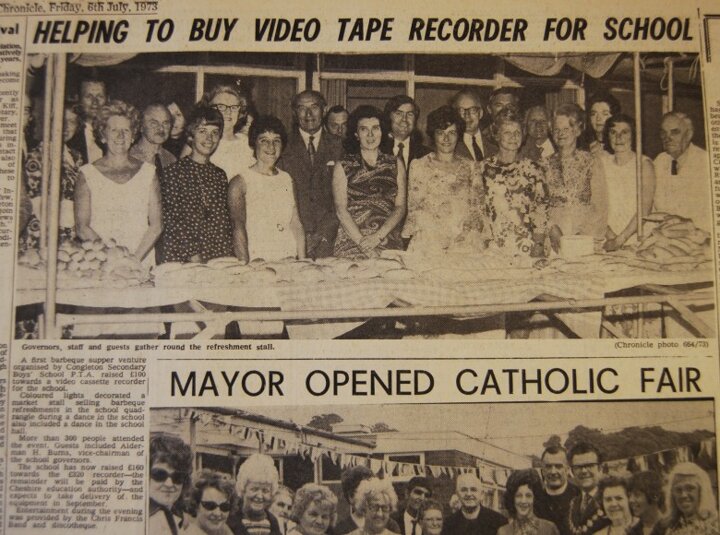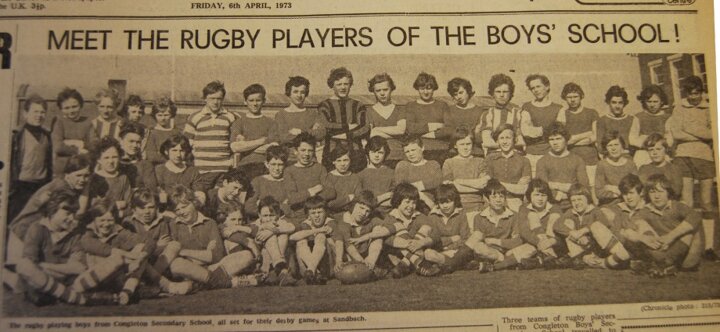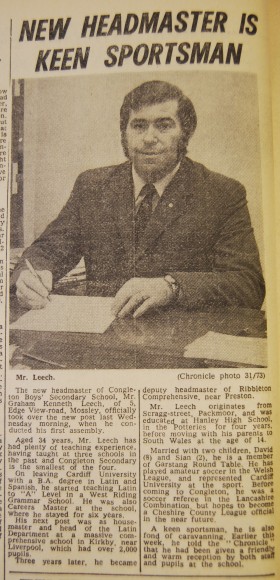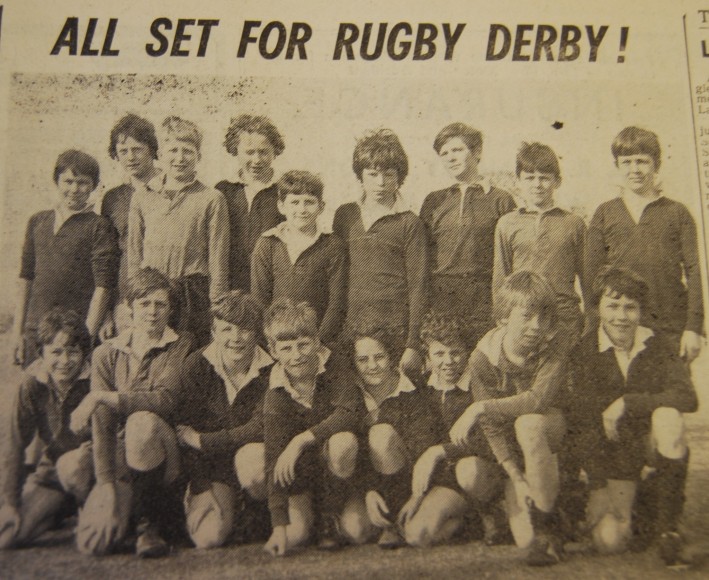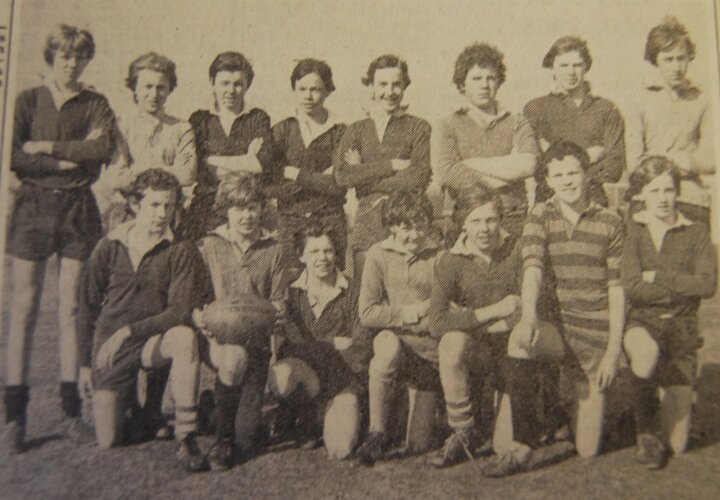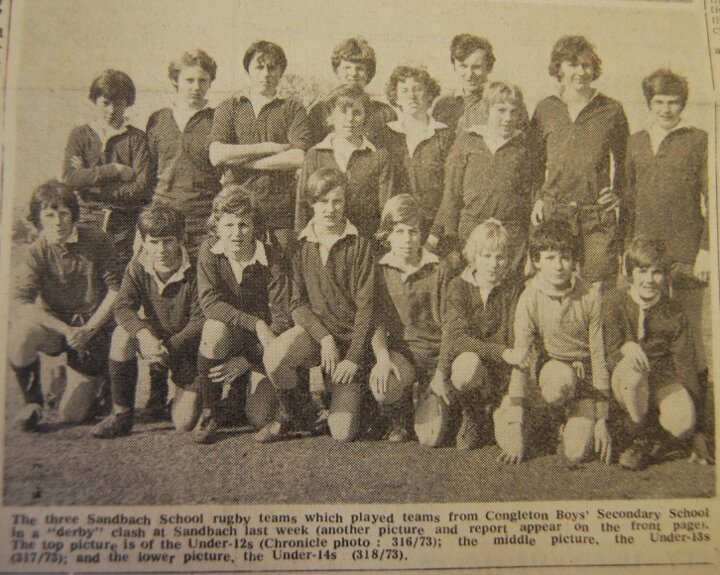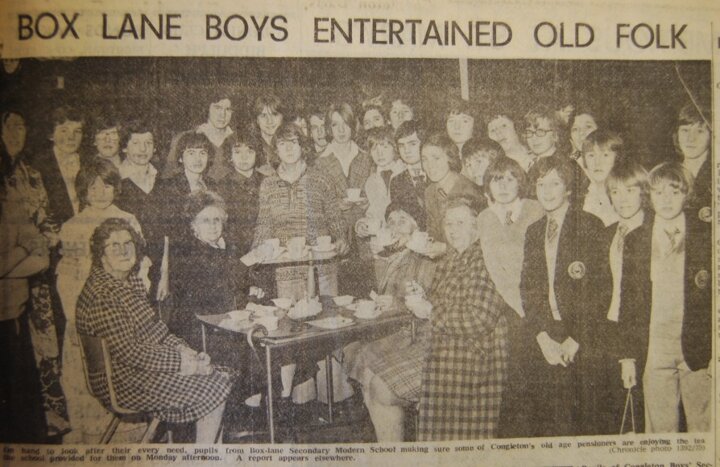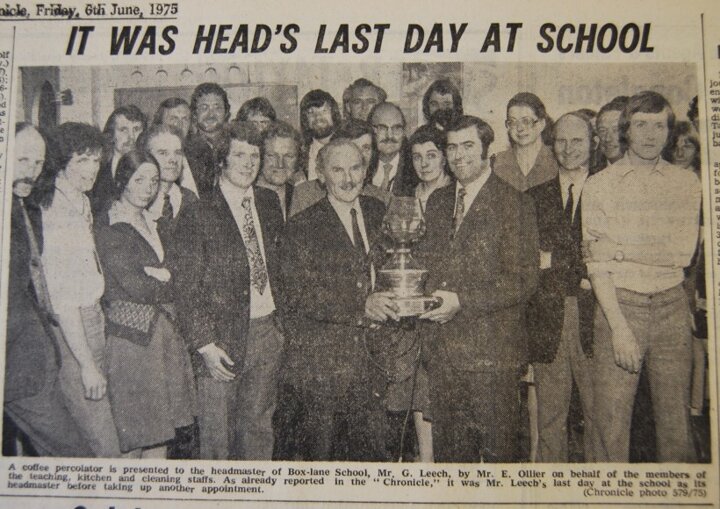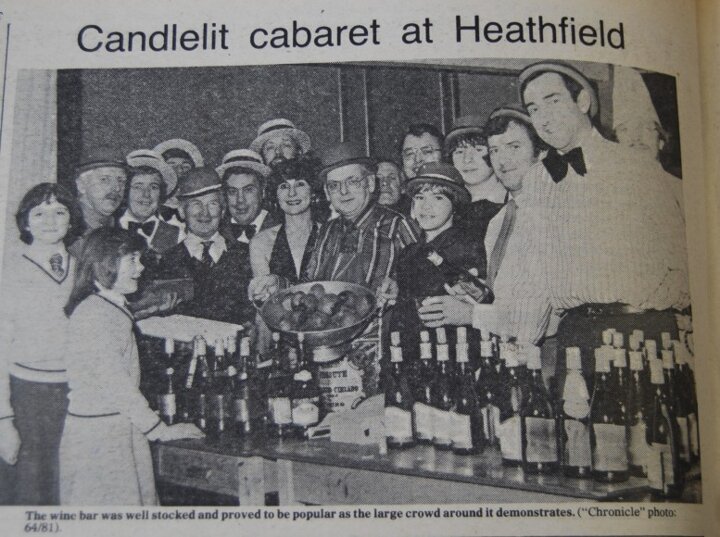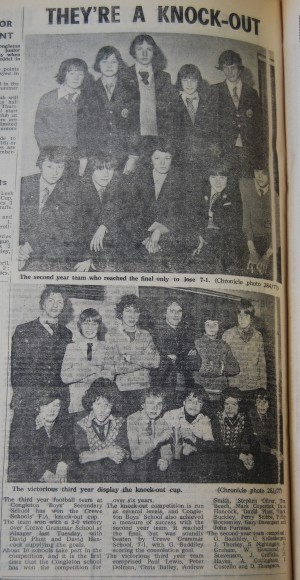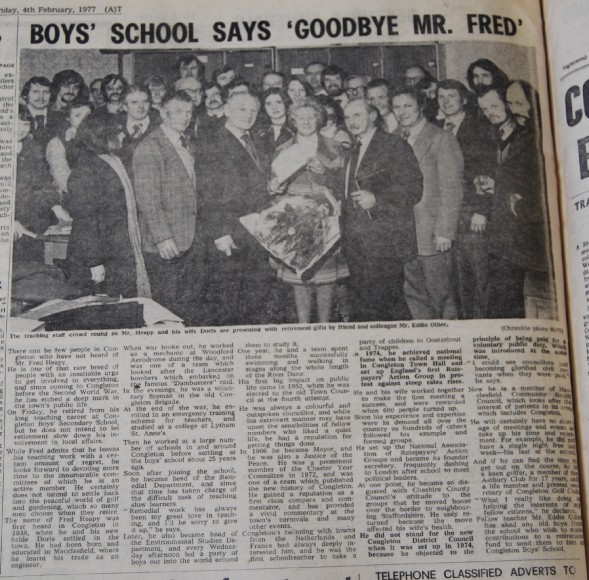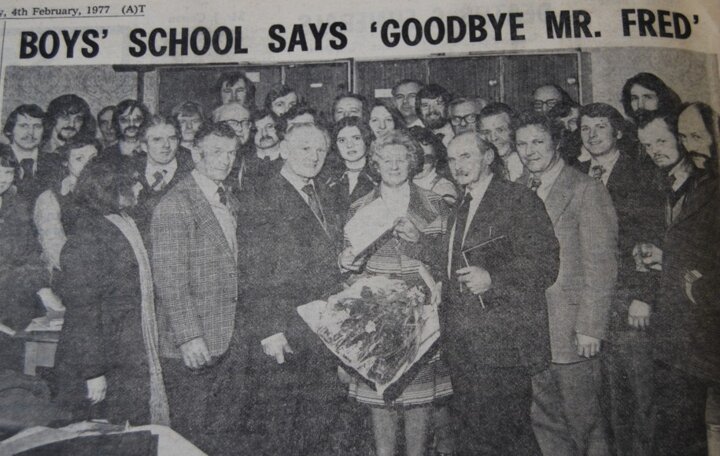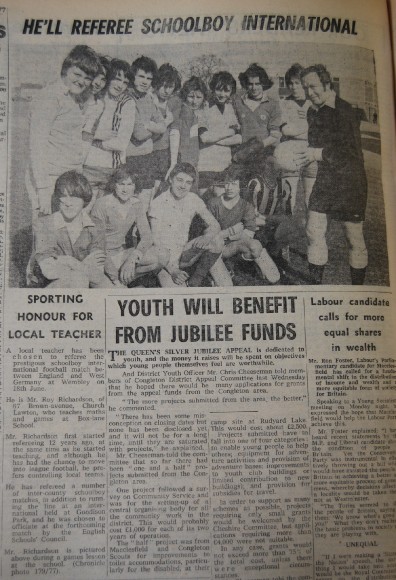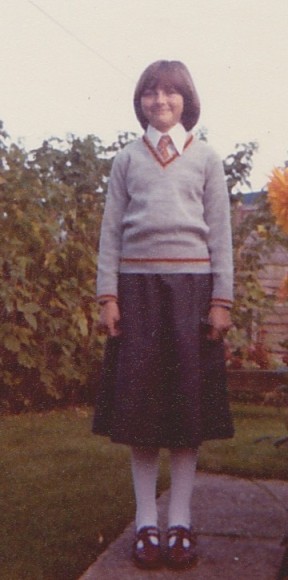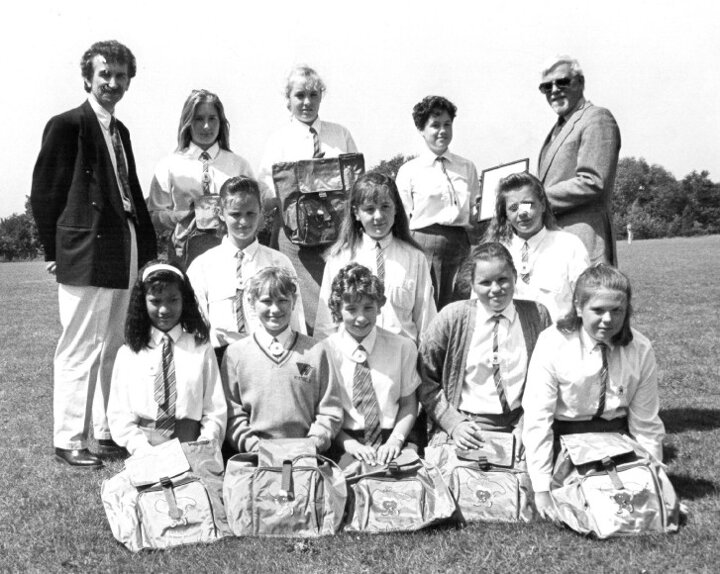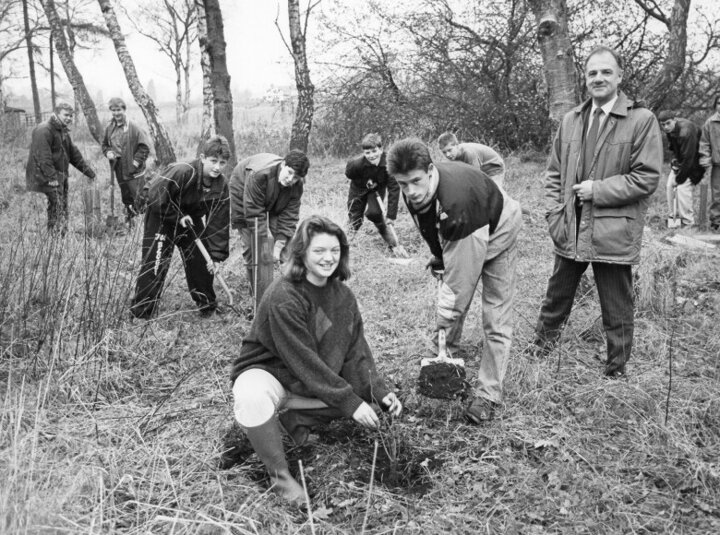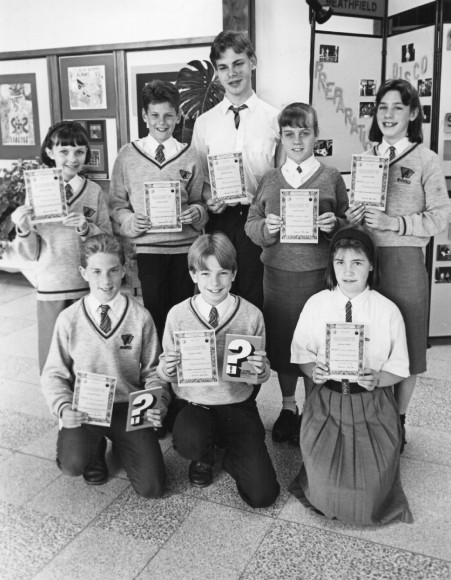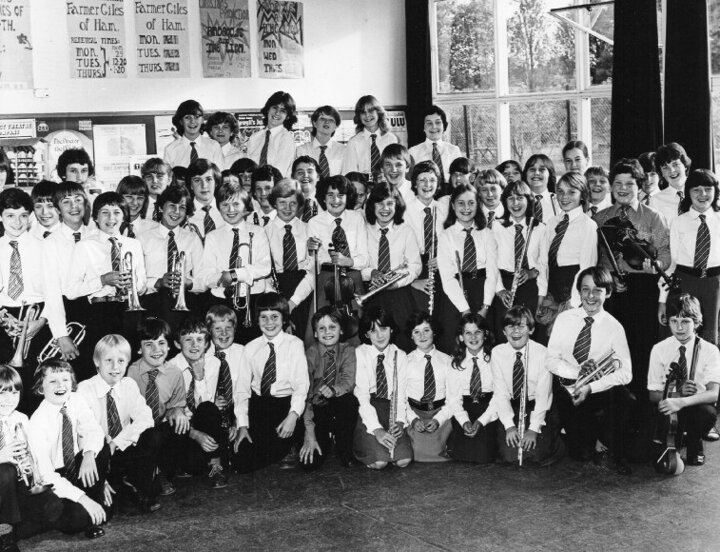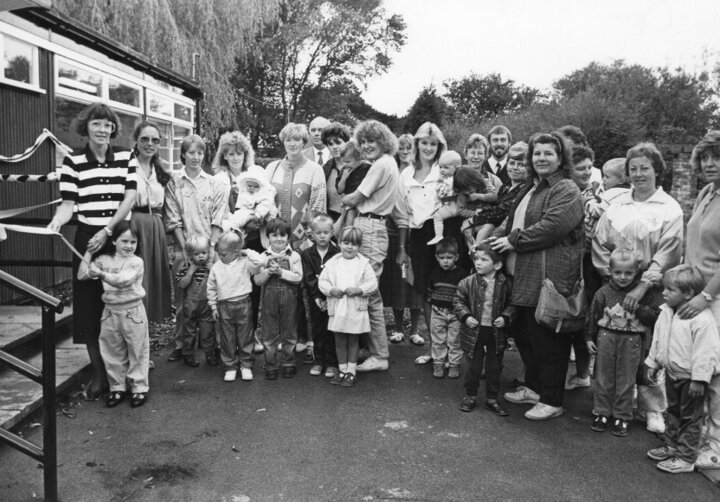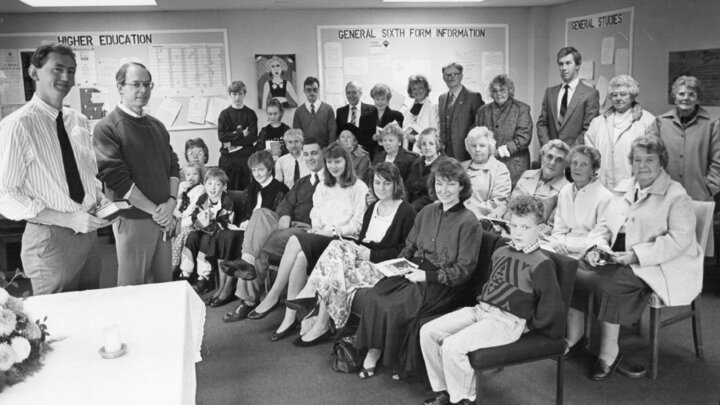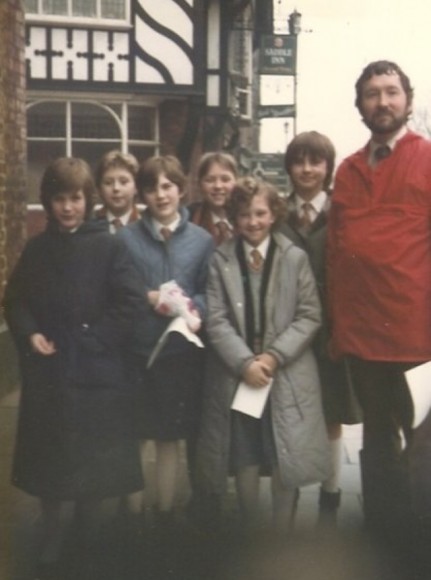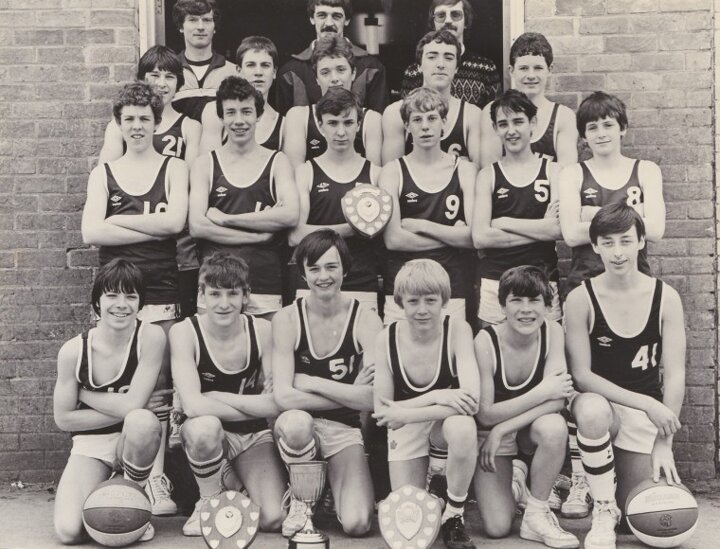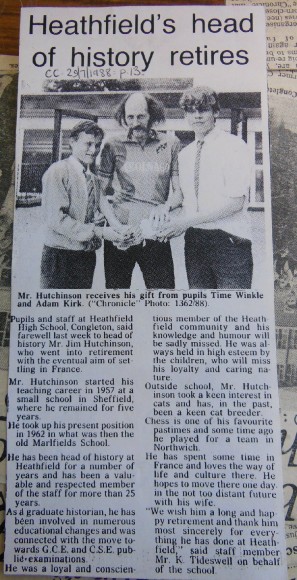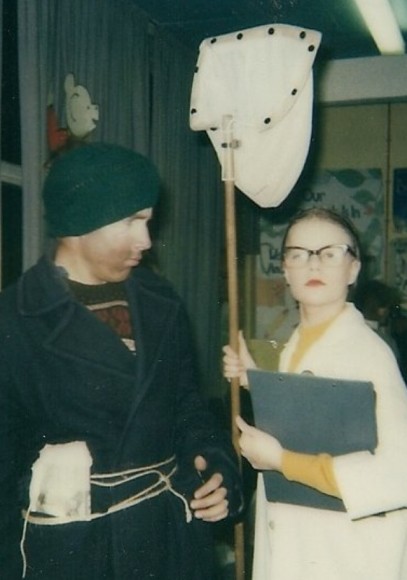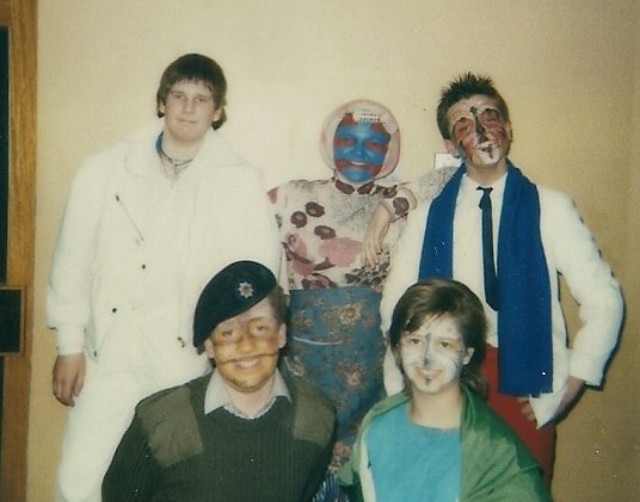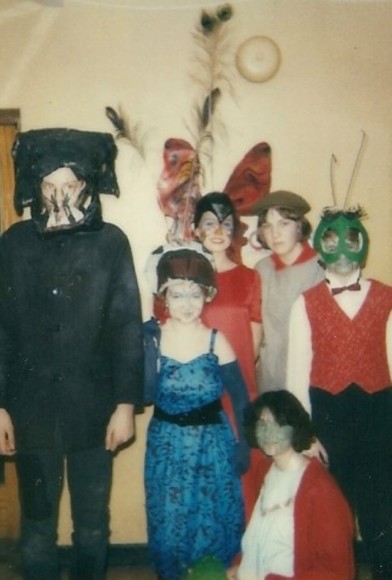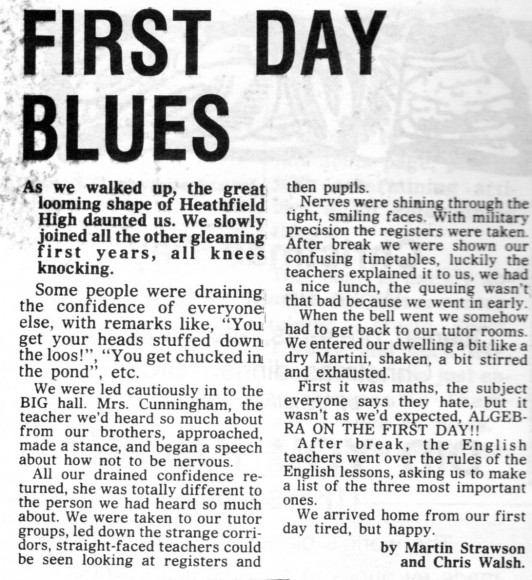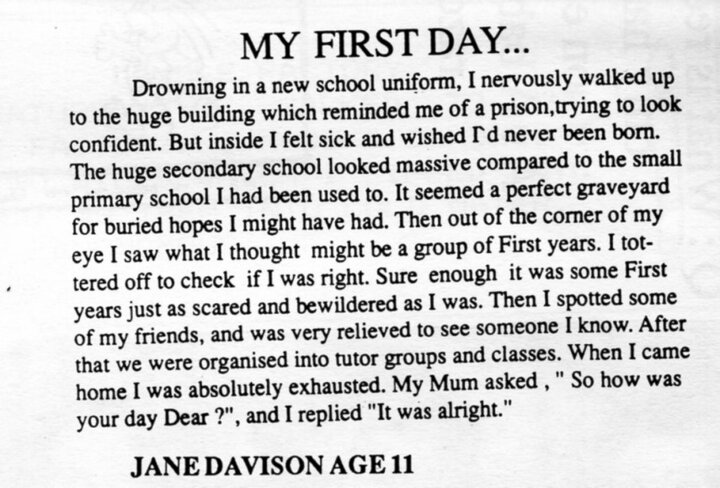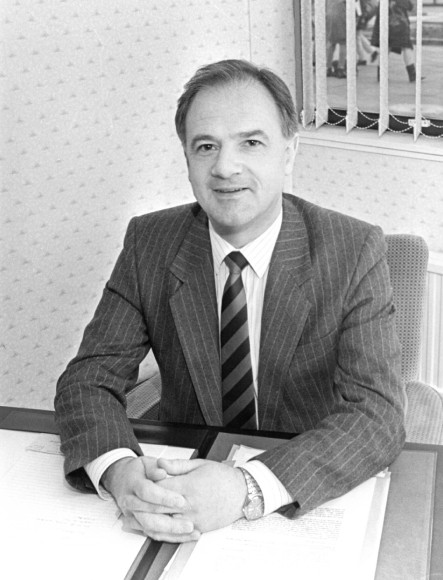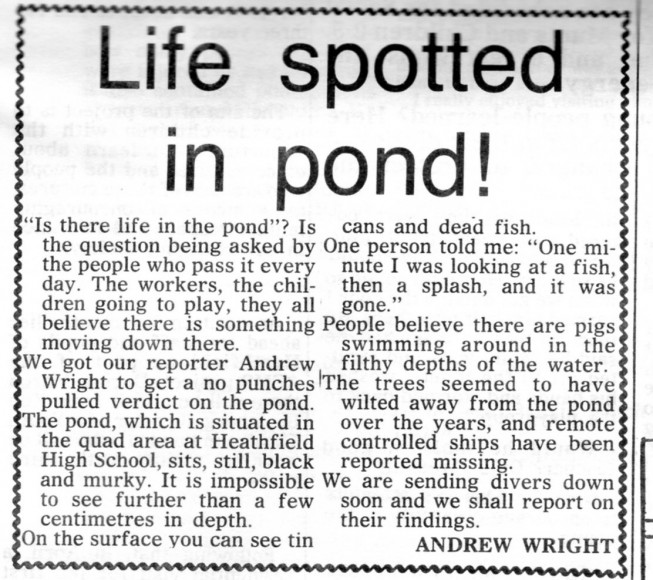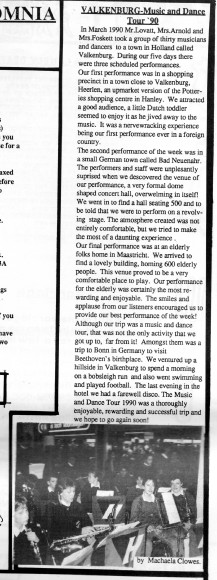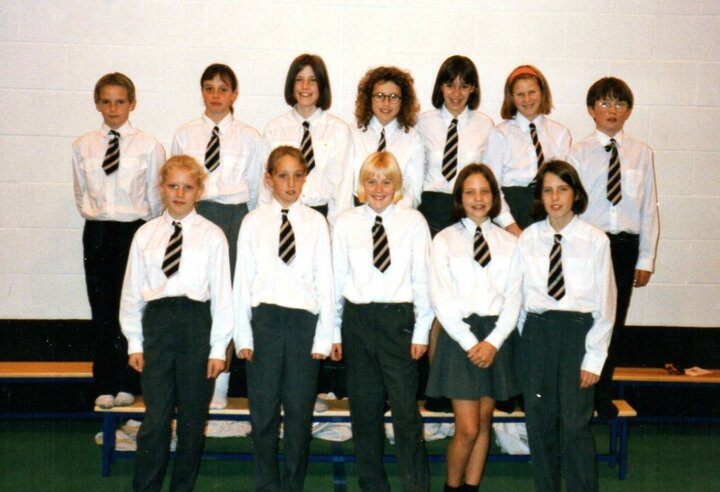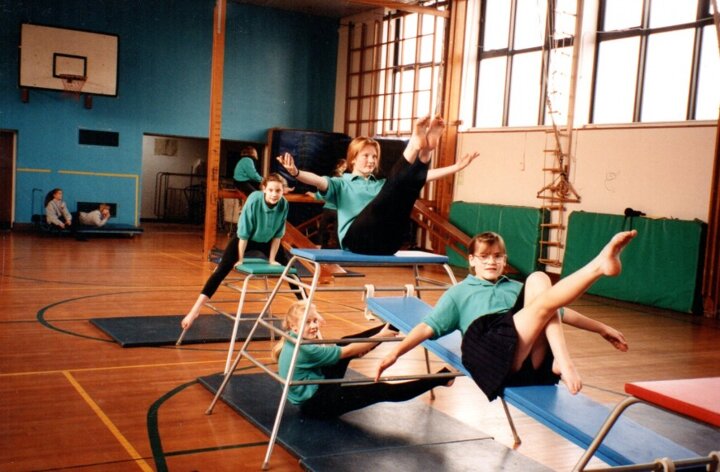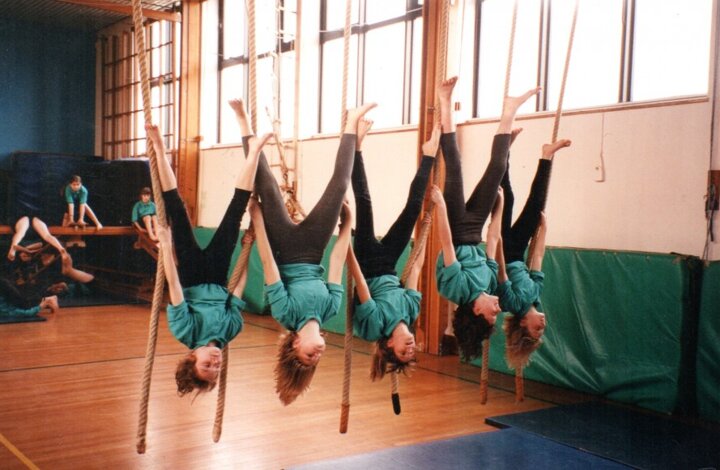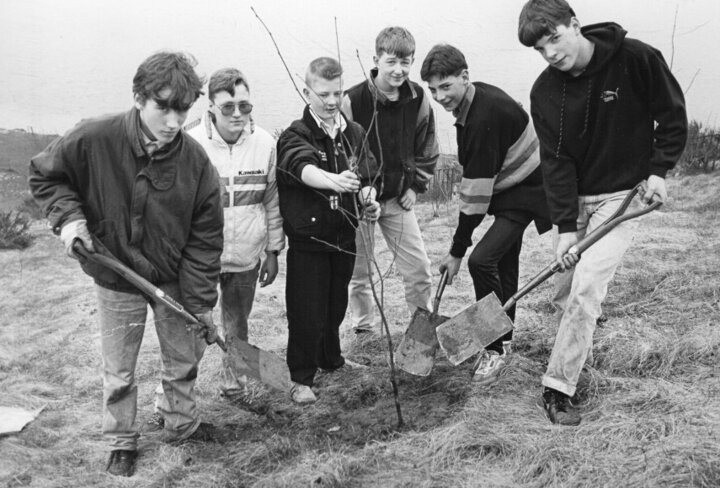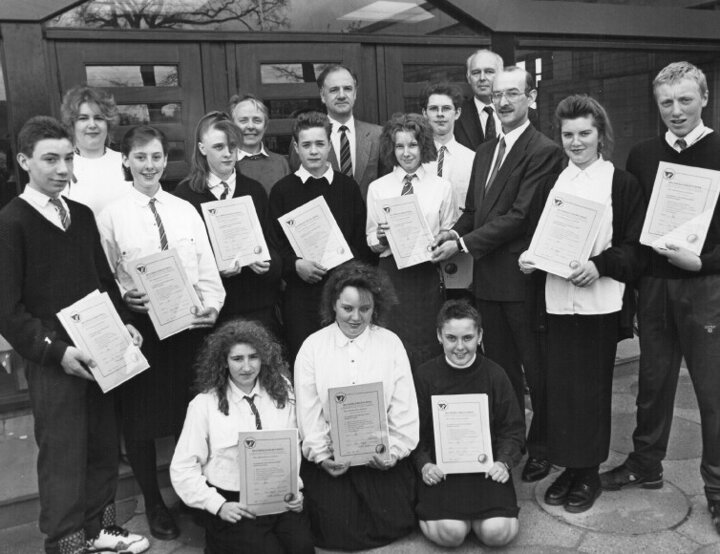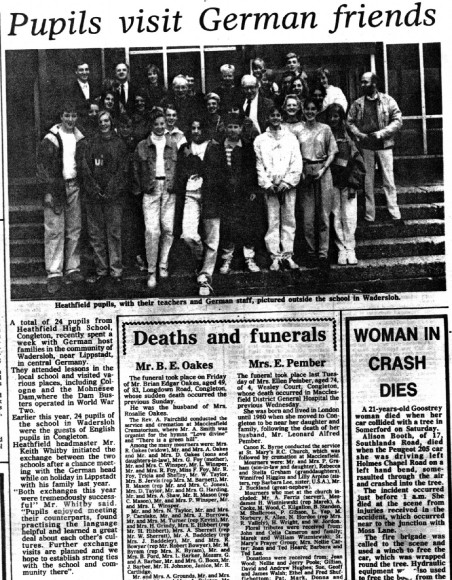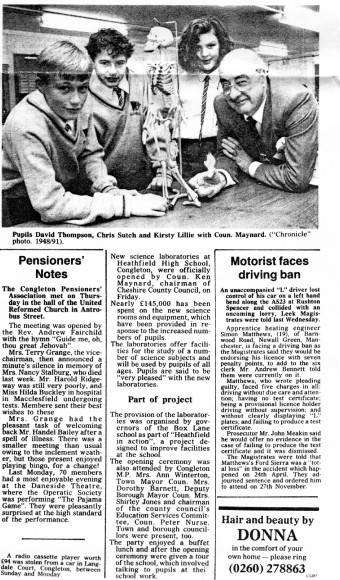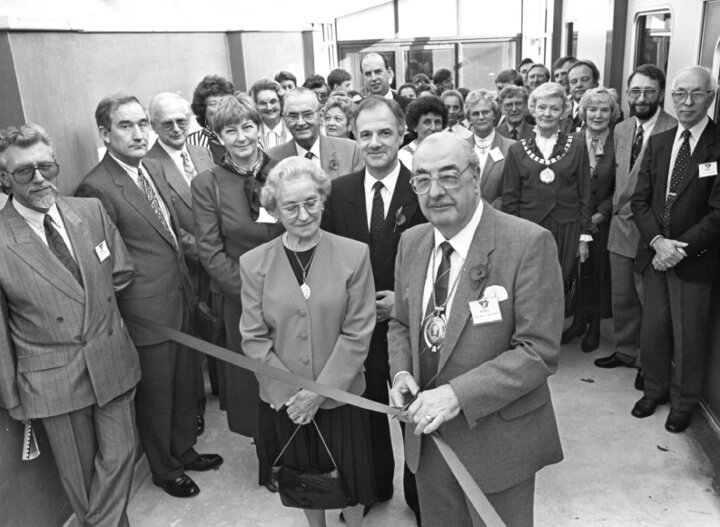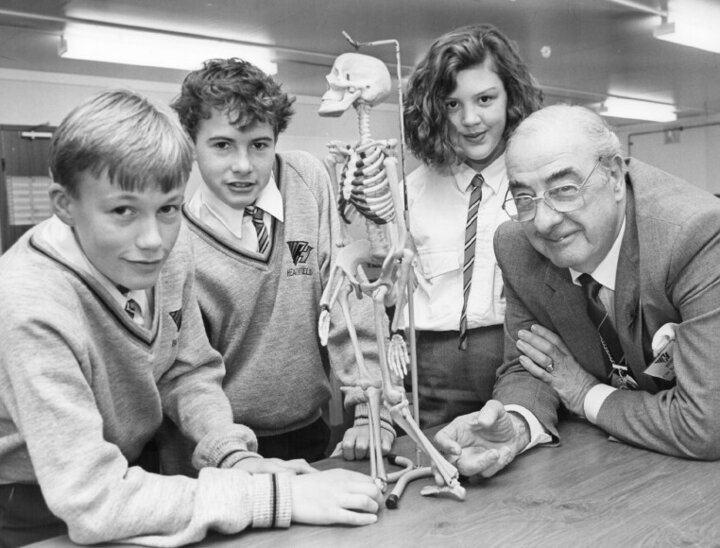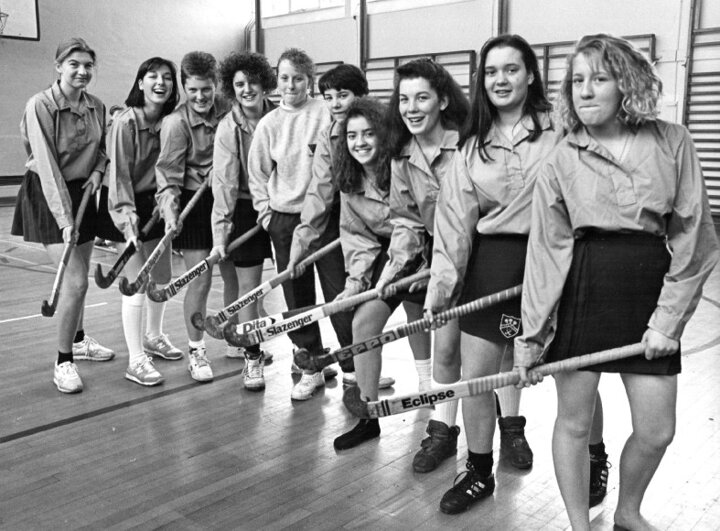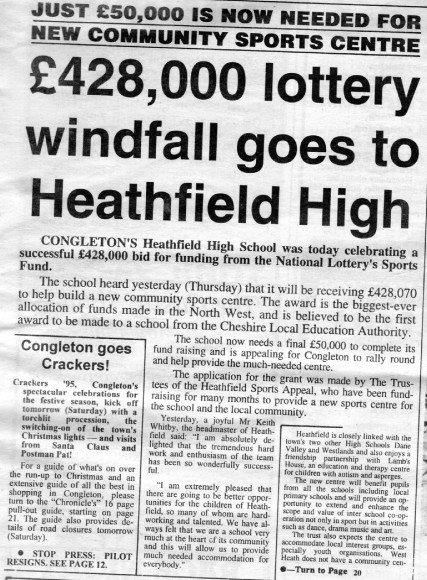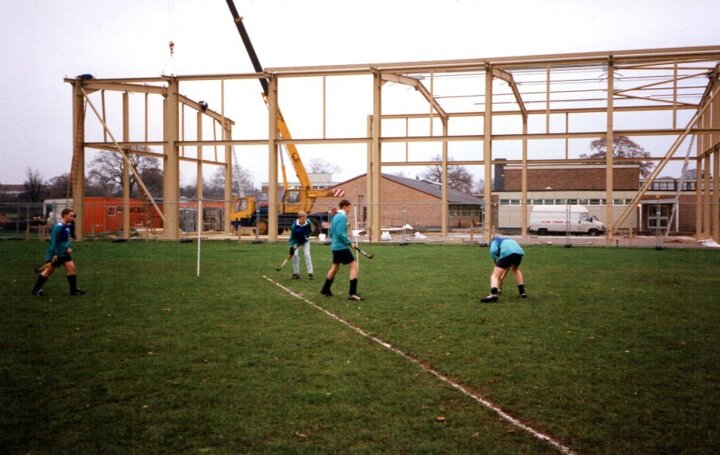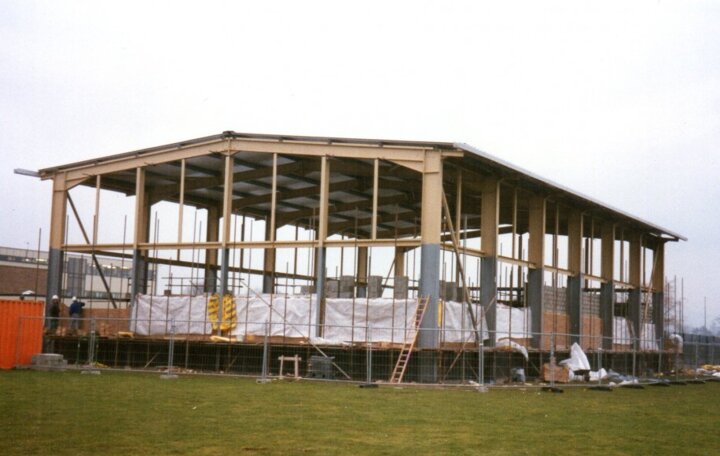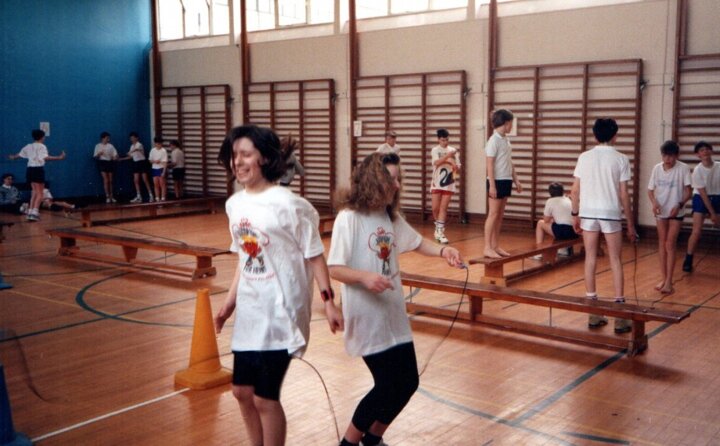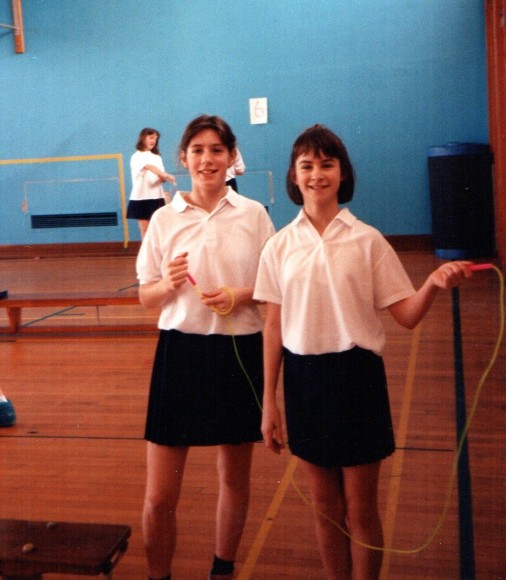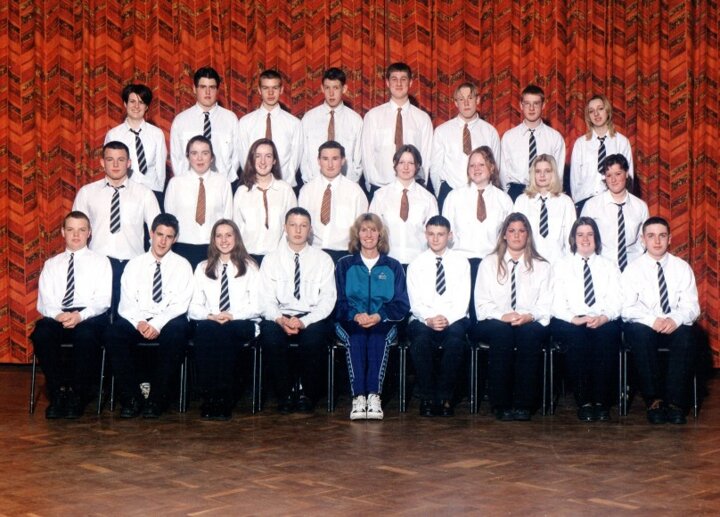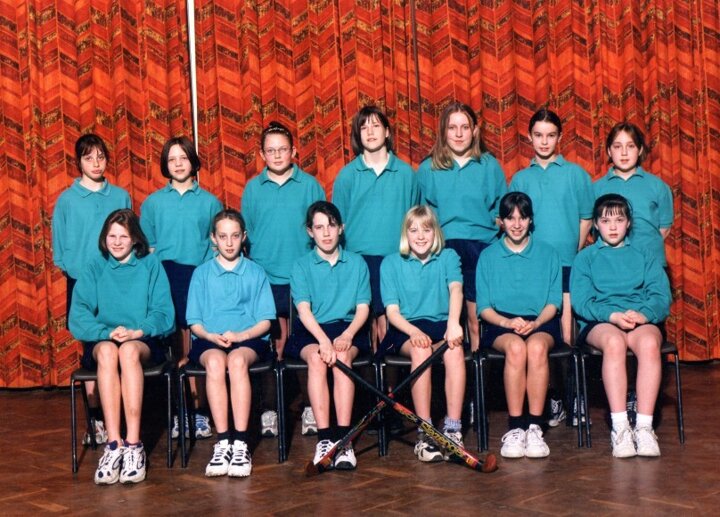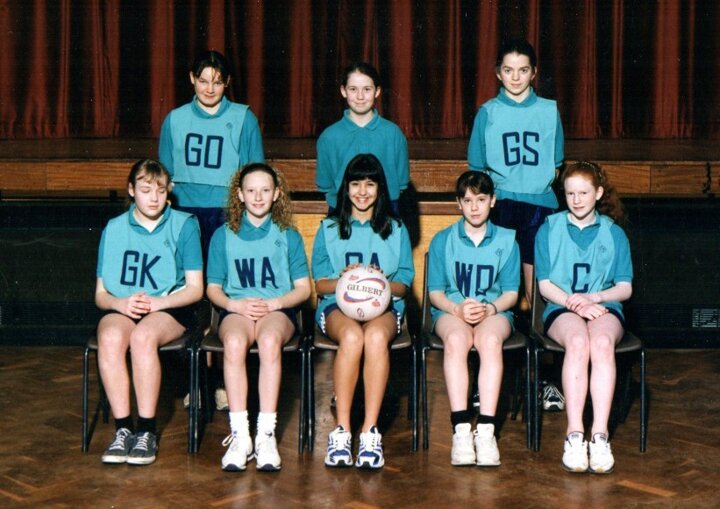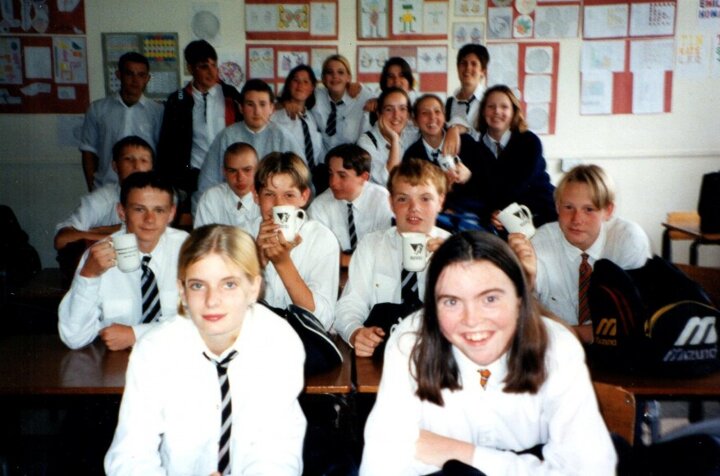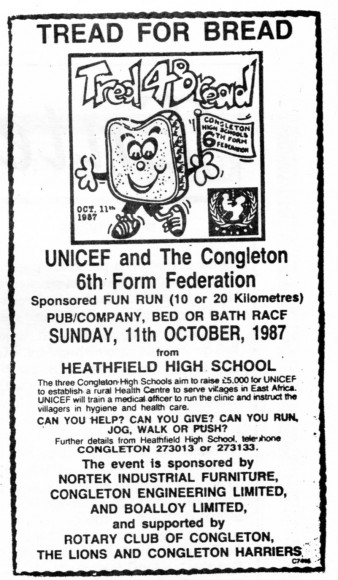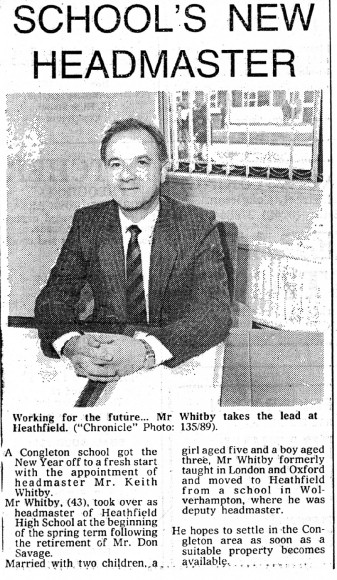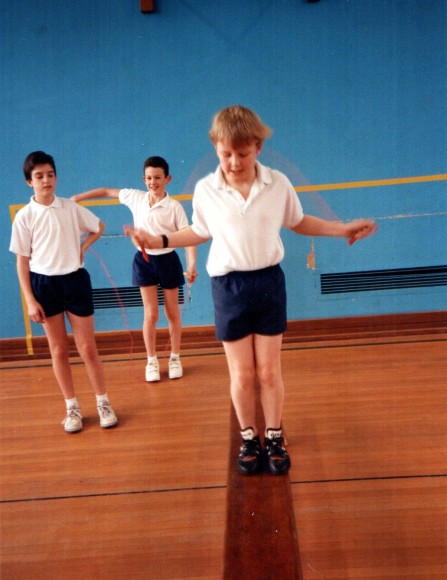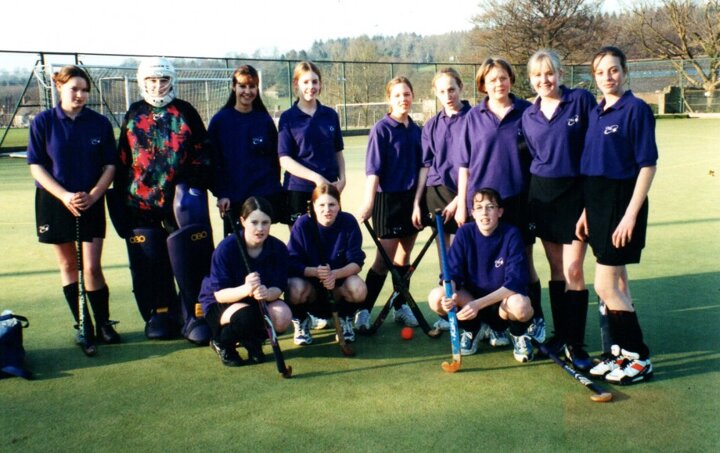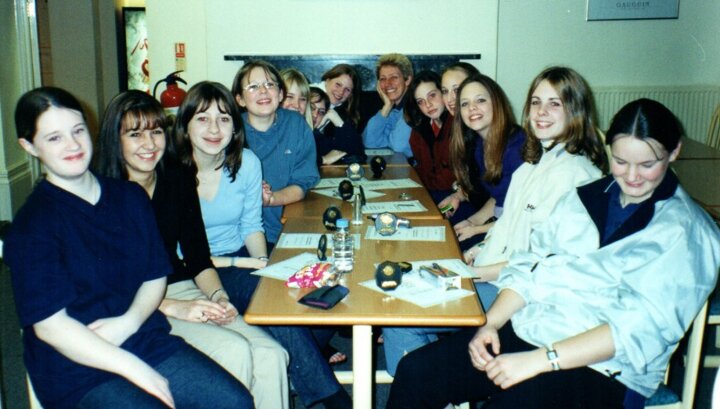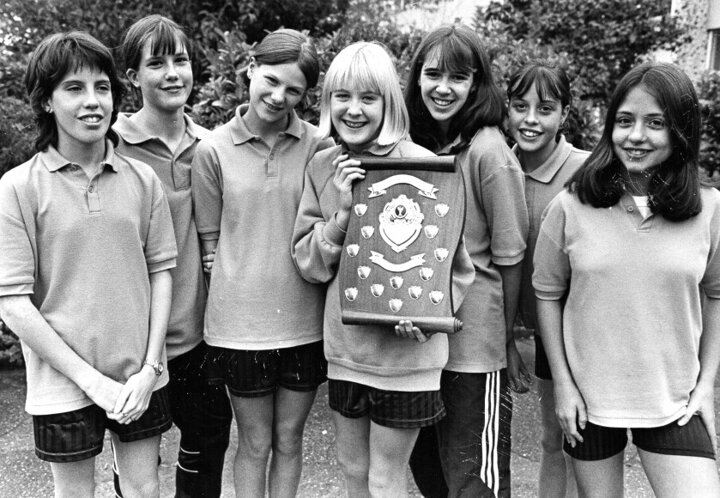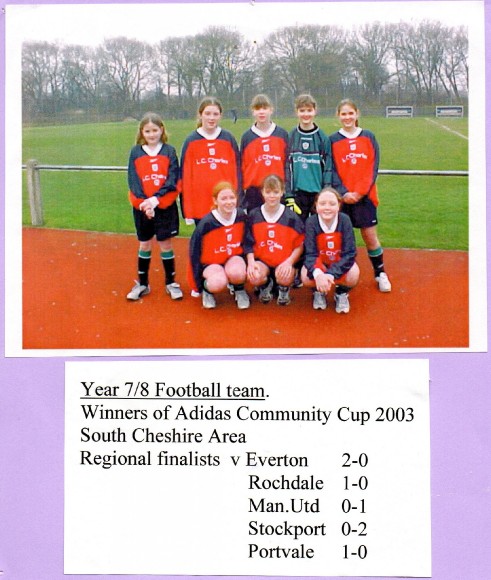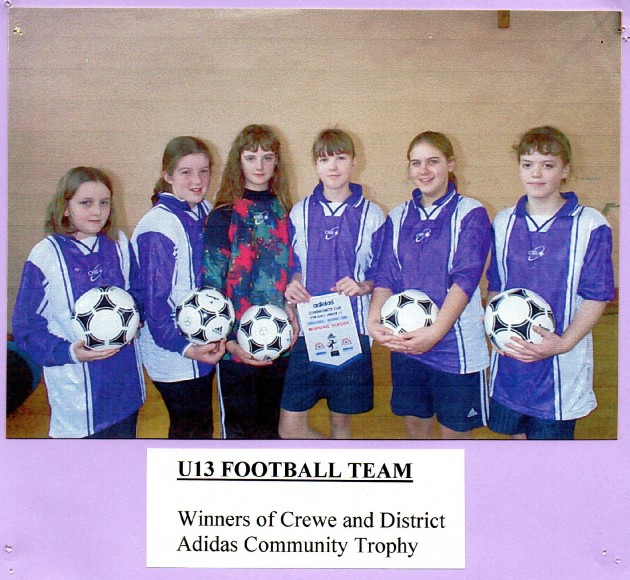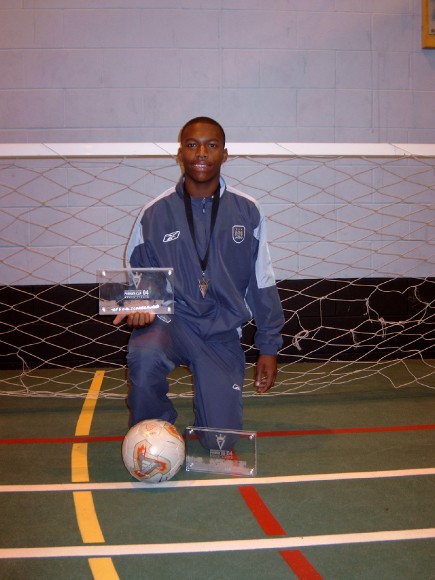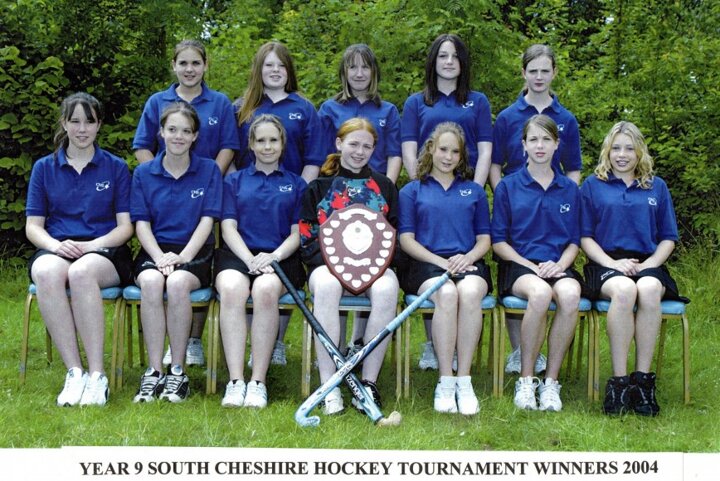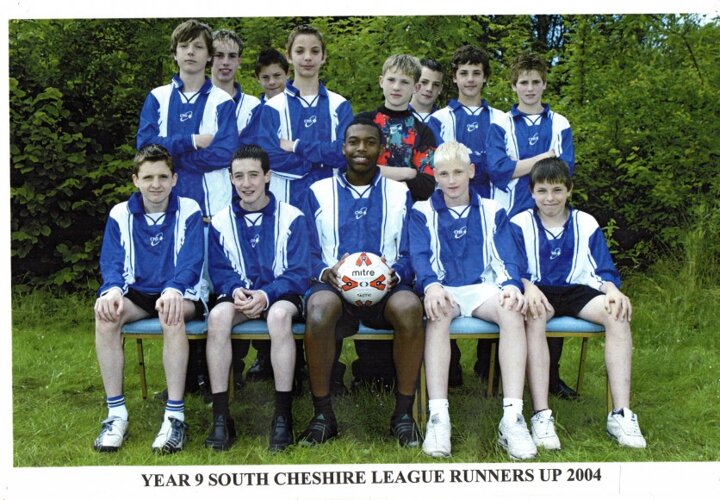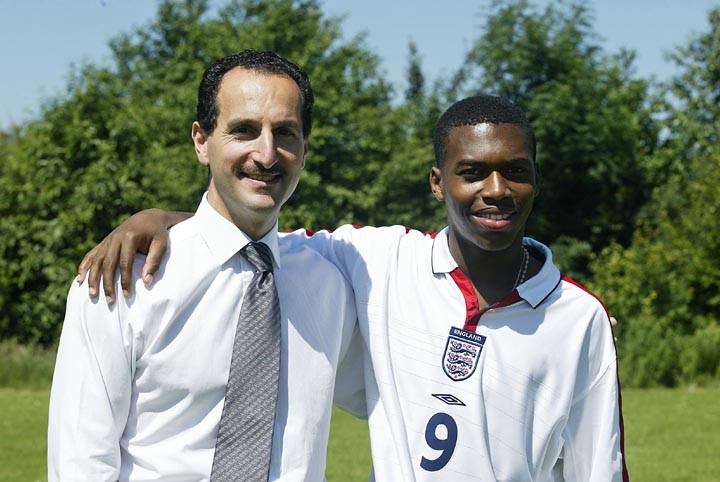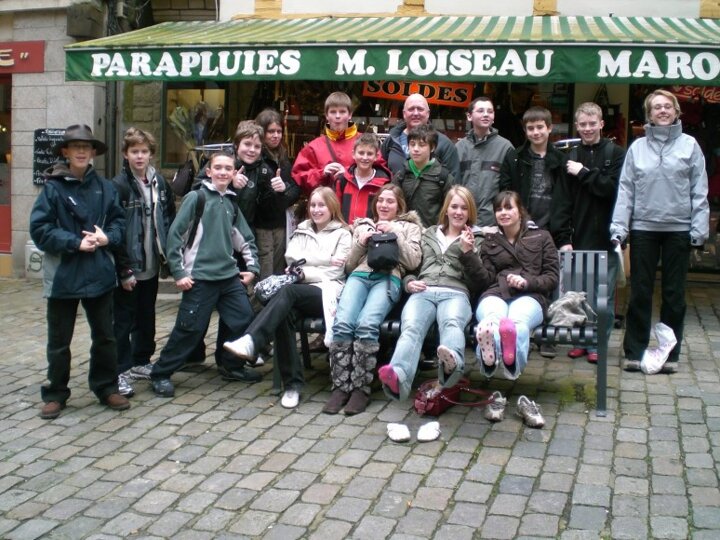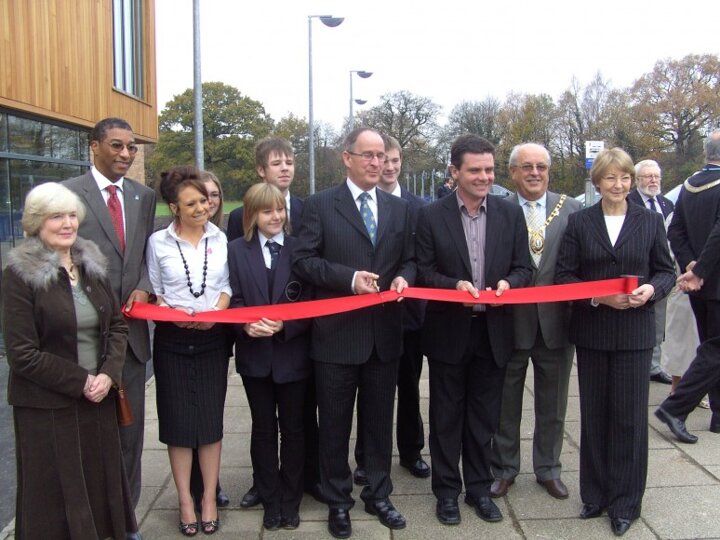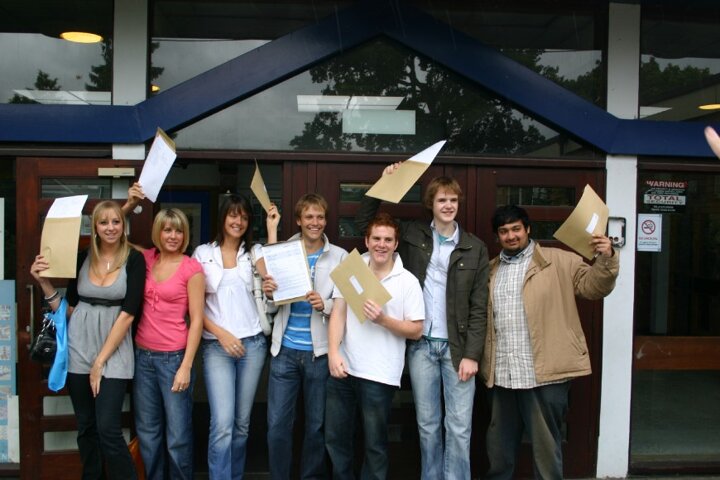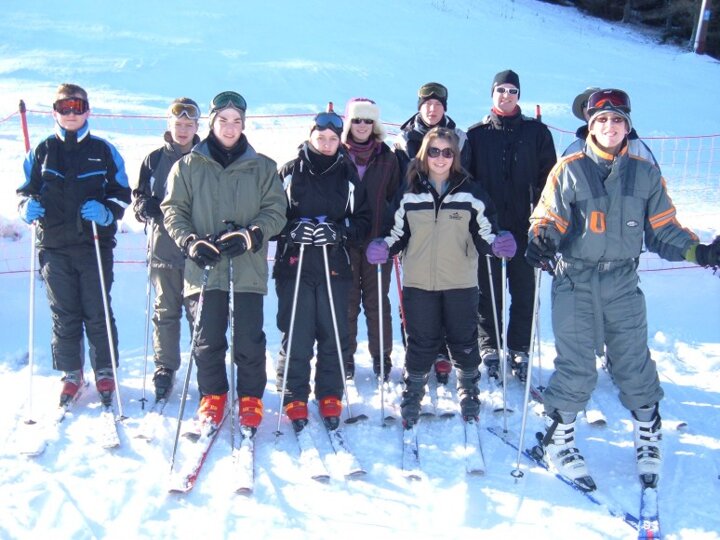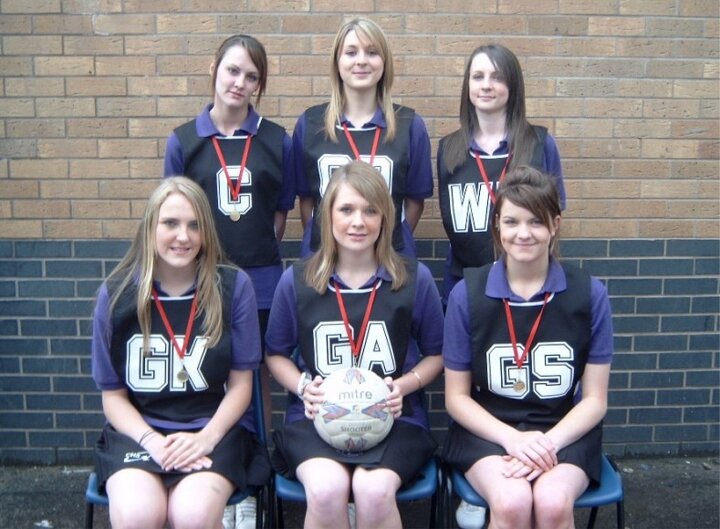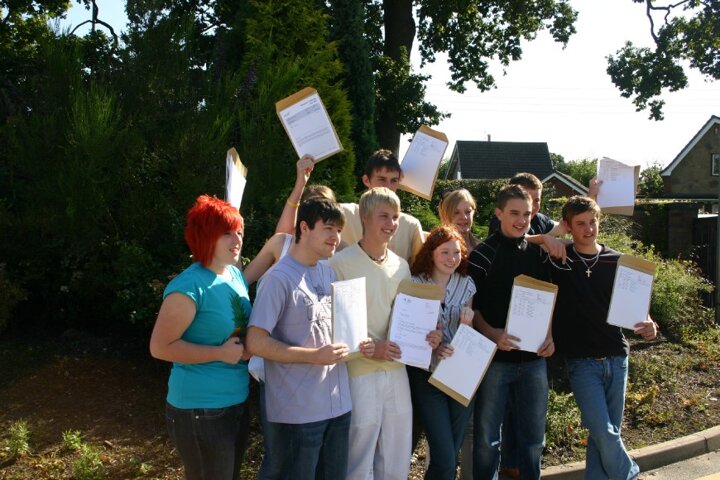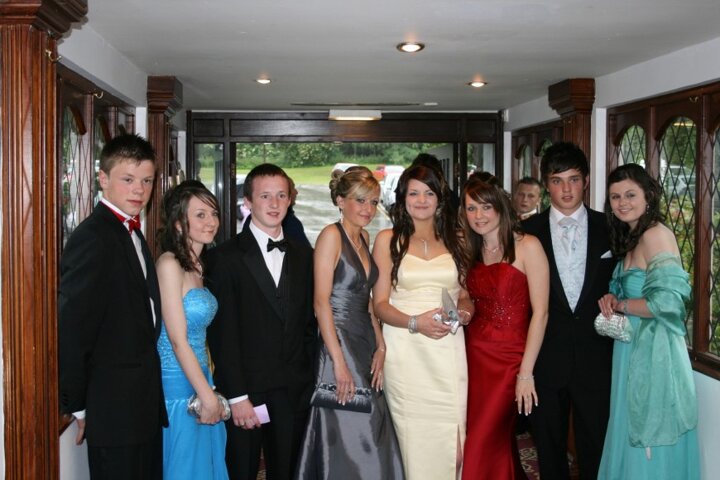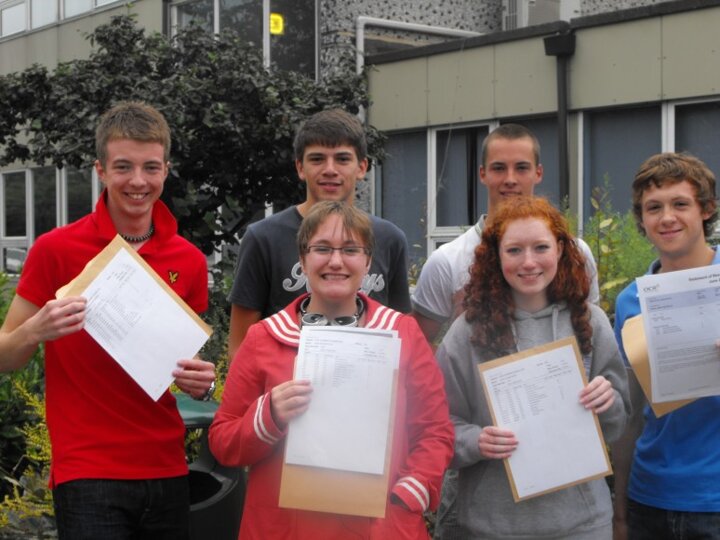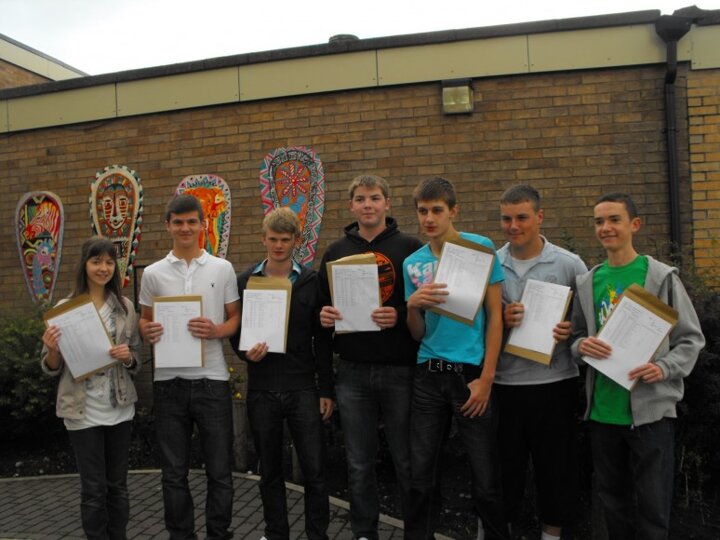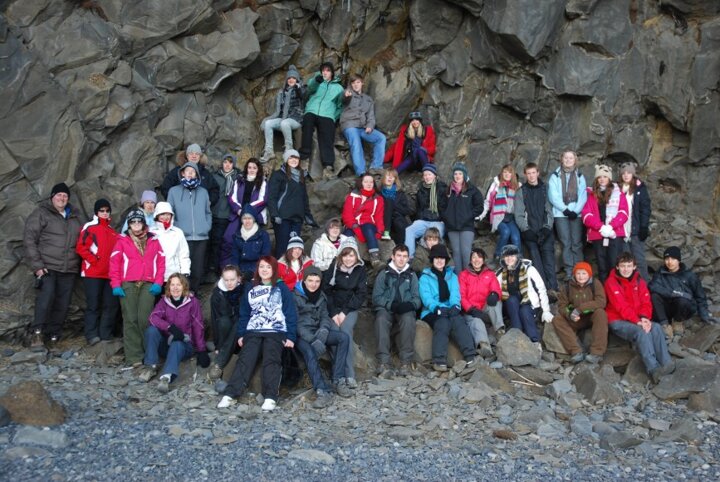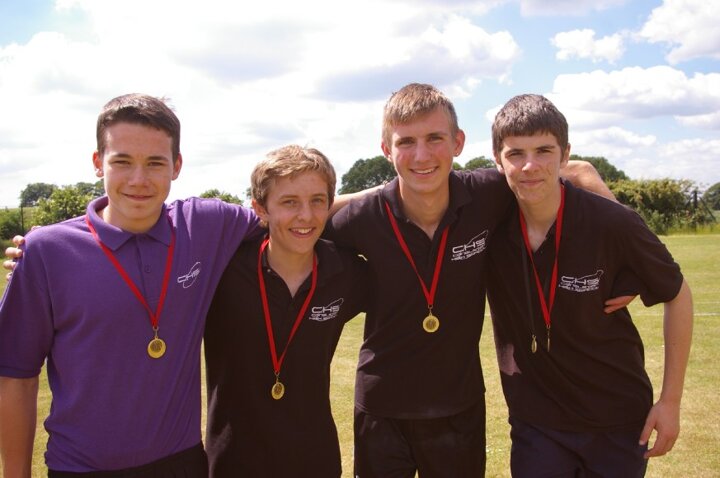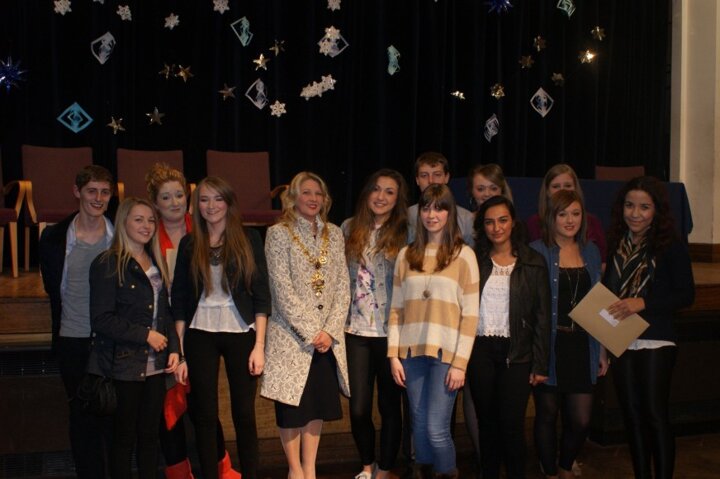Congleton County Secondary School for Boys, 1964 - 1979
First days
According to the programme from the official opening, the Congleton County Secondary School for Boys was “the 46th secondary school to be official opened since the inception, in 1949, of the County Education Committee’s Annual Building Programmes.” The existing boys school moved from its premises on Waggs Road in Congleton (now Marlfields Primary School) to the new school buildings on Box Lane in October 1964. It was designed by the County Architect, Mr E Taberner and built by Messrs A J Pass & Sons Ltd. The programme from the official opening records that “The total cost of the buildings, furniture and equipment and the lay-out of the playing fields amounts to approximately £222,000.”
One former teacher, Roland Machin, started work at the boys school in 1963 and subsequently worked at all 3 schools over a period of 38 years. He recalls that the new school wasn’t ready for the start of the new school year in September and so they didn’t move in until the October. “There were contingencies including a stream running under the middle of the school, which was the reason for the delay as they had to sort out the drainage.”
Nigel Watson was a student at the time and he remembers what it was like: “On the first day of the school opening, I remember the school field was like a First World War Battlefield. There was no grass, just earth with trenches dug for drainage. A tarmac playground with a tree at the edge away from the school was ready for use. Everything seemed big and new to me as I was straight from junior school.”
Cattle truck
Mr Machin recalls: “We borrowed Mr Lomas’ cattle truck over the weekend to effect the move. There were about 375 boys from all over Congleton and surrounding areas.” He also recalls the original Headteacher, Mr Harold Shanassy, who had opened the school in 1937 was highly respected in the town and by the LEA though sometimes quite relaxed. “Before I joined the school I rang him to find out when school term was due to start ,he didn’t know. In fact, no-one seemed to know. In the end I had to ask some of the boys in the town!”
Opening Ceremony
The official opening ceremony wasn’t performed until 7:30pm on Friday 19 March 1965, when the school was officially opened by Sir Wesley Emberton, Deputy Lieutenant and Chairman of the County Council. The buildings were declared open and handed over to the Governors, Chaired by W H Semper Esq. The hymn ‘All People That on Earth Do Dwell’ was then sung and prayers and thanks were said. The ceremony ended with the singing of the National Anthem, following which the school was open for inspection.
Officer’s Mess
Mr Machin, nicknamed ‘Scratcher’ also recalled that many of the original teachers had fought in the war. “The staff room was a not unlike an officer’s mess in those days. At break and lunchtime teachers would be smoking, playing chess and reading The Guardian. And of course there were no female teachers until the early 1970s. Sandy Farmer was the first, and then Pat Smith”
Curriculum
Even back in the 1960s, the school was very strong on engineering. Mr Machin: “There was no national curriculum in those days - the school and individual staff built their own curriculum.”
Congleton County Secondary School took boys from Congleton and surrounding areas from the age of 11 until 15. Boys who passed the 11+ exam went to Sandbach Boys school. According to the programme from the official opening, the school provided “a general course of education for pupils in their first two years , including such subjects as English, mathematics, history, geography, science, art, music, religious instruction, physical education, woodwork and metalwork.” Then at age 13, in addition to their general education, boys were selected to follow one of the three Alternative Courses – technical, rural studies or practical. The technical course included such subjects as mathematics, science, woodwork, metalwork and technical drawing. Rural studies included horticulture, agriculture, livestock keeping and rural science whilst the practical course included woodwork and gardening. The school even had its own allotment at the back where the current tennis courts are.
Former Headteacher, Don Savage also recalls that the school won a curriculum award in the early 1970s. “Jean Wilde was our Director of Studies. She was brilliant – the kids loved her. We had to present our curriculum ideas and we won an award. We went to London with some students to collect it and were presented with a certificate and a painting by the speaker of the House of Commons. The painting used to hang in school.”
Right from the start, the school’s strengths were in practical work, PE and, above all, Engineering. As now, the school had links with local industry such as Bentley Motors and with the Crewe works (British Rail). A lot of boys went into engineering or farming. Don Savage remembers that “Local companies like Fodens and Rolls Royce and also British Rail were desperate for our kids to become apprentices.”
Mr Machin developed Motor Vehicle Studies as a vocational school based examination subject. He enthused generations of students in the subject and even had doors put on the side of the Technology workshop so that they could build a car in school and get it in and out of the building. The photograph below shows the car that the students built for the BP Build-a-car competition (in the early 1970s). The competition was to build a car that was manoeuvrable around town.
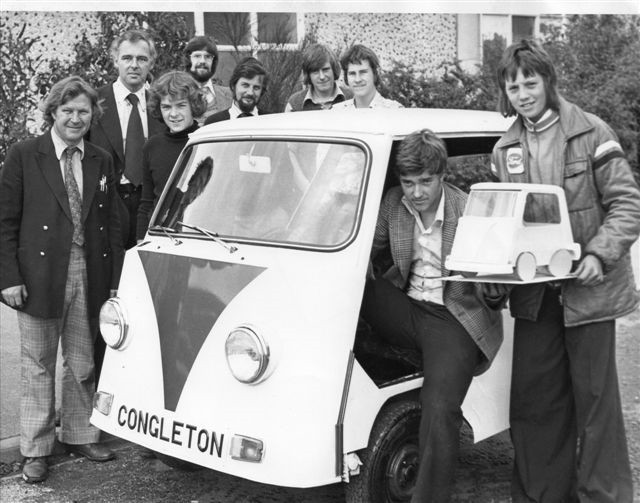
Former Art teacher, Bob Griffiths, recalls that Art used to be upstairs in the main teaching block. “We had a ‘light craft’ room where we did basket weaving, cane seating, resin casting and book binding. Then boys also did ceramics and painting and drawing.”
As part of their physical education, boys had to do a cross country run, which set out from school across Loachbrook farm, past the Wagon & Horses, onto Back Lane, then Black Firs Lane, finishing with a lap of the school field. Former students Peter Plant and Chris Jones remember it well. “You always had to do this cross country circuit and you had to cross the Loach Brook. The 4th years would stand by the deepest part of the brook and make sure that every boy went right through it. And there were no shortcuts – there would always be a member of staff on a bike waiting in case you decided to try and nip back across the fields.”
The School Day
As Roland Machin recalls, the school day started at 9am. “Staff blew a whistle and the boys lined up in their form groups. The same happened at break and lunchtimes. The lunch break was about an hour and a half, giving boys plenty of time for activities and staff enough time to go to the pub, including Mow Cop!”
Former student Peter Plant recalled how things were for the boys at lunchtimes “You sat at large mixed tables with students from different years. Each one had a Head of Table and two servers, usually 4th or 5th years. Nine times out of ten, the Head and Servers got half the tin of food and the rest went to the ‘menials’!” “You had red dinner tickets, which were 2 shillings a week. Then it went up to 2 and 6 and later to 5p. Later on they stopped serving it at the tables and boys had to line up. Then it became a free-for-all; when the bell rang, you just ran!”
Nowadays parents and students are in touch directly with teaching staff and tutors via the telephone and e-mail. But as Mr Machin recalls, things were very different in those days. “Once school had started each day the caretaker Fred Snelson closed the gates– parents only came to school by invitation.”
Former student, Chris Jones, remembers that the school had different ‘houses’ and that everything was done in these different groups. “Originally we had St Patrick, St David, St Andrew and St George, but in about 1973 these changed and we had Telford, Wedgewood and Brindley.” Chris and Peter remembered the Headteacher at the time – Mr Butterworth. “We called him ‘Strutter’ because he was a tall bloke and he used to strut about. He had a very old car too – a real bone shaker!”
As former student Nigel Watson recalls, there was an assembly every morning for hymns and prayers. “The school hymn was ‘He who would valiant be’ and the Headmaster, Mr Shanassy, led the assembly from the stage with the prefects sitting down behind him. The older boys at the back of the hall would only mumble the words, except when he got us to sing ‘The Battle Hymn of the Republic’ when they would sing ‘Glory, Glory Hallelujah’ as loud as they could!” He also remembers one occasion when a boy with long hair came in to the assembly late. “Mr Shanassy stopped the singing, got some money from his own pocket and gave it to the boy, telling him to go out again and get his hair cut!”
Uniform
Mr Machin recalls that they didn’t have a rigid uniform policy at the boys’ school; “There was a poverty in the town at the time – some pupils didn’t even have shoes or trousers.”
School trips and events
Mr Machin recalled that the school always took students to the Cheshire Show and to the Motor Show and later (in the 1970s) took trips abroad to France. He said “I remember we had a float in the Congleton Carnival each year, including a psychedelic car in the early 1970s. The school also owned a 42 seater Bedford bus. Teachers had to do a 2-day driver training course to be able to drive it and they used it for day trips out. It only had a top speed of 47 mph and the Rural Studies teacher used to collect muck in it, so sometimes it smelled awful! We used to use the fire hose to clean it out.”
There was a strong tradition of outdoor pursuits at the school, as former Art teacher, Bob Griffiths remembers “Boys did sailing at Tatton Park, Redesmere and Menai under the leadership of teacher Geoff Watson; rock climbing under the leadership of teacher Graham Cole and canoeing and kayaking led by teacher Roy Curtis.” He also fondly remembers a funny story that happened one snowy lunchtime. “For a while I ran a lunchtime running club where some of the older lads and I would go for a half-hour run around a circuit based on Blackfirs Lane. One snowy lunchtime we set off, watching younger kids snowballing on the field as we ran past. They had obviously seen us too, and were lying in wait for us as we ran back later. I have never seen so much airborne snow! We couldn’t dodge or duck them, we just had to run the gauntlet laughing uproariously. It was brilliant fun!”
Roland Machin: “I remember taking students driving cars around the Silverstone circuit one Sunday morning. We had designed and built a 4-wheel-drive car and the boys drove it round the circuit!”
The school had a science teacher called Jack Nicklin who was remembered fondly by a number of students to whom we have spoken. Mr Griffiths told us that he was "An amazing teacher who really brought the subject alive - the students loved him! He was also good at mending stuff like broken transistor radios and he had a team of boys he called his 'sleuths' who would go and find things that needed fixing and bring them back to him to work on." Brian Richardson, who was a student at the school in 1964 remembers a school trip to visit the Atomium in Belgium one year: "We were in the lift going to the top of the Atomium, which at the time had the fastest lift in the world, but part way up it stopped. Anyway, Mr Nicklin went in the top pocket of his jacket and got out a screwdriver. Then he took the front off the control panel, did something to some of the wires and we were off again! It was amazing!"
ROSLA building
In 1972 the school leaving age was raised to 16 and it was at that time that the Rosla (Raising of the School Leaving Age) building was added (now the Art/ICT block)
Former student Chris Jones remembers that there was a lot more freedom for the students in those days. “We used to go up to Mace’s shop on the corner of Back Lane and Holmes Chapel Road and every lunchtime the ice cream van would pull up outside school so we could go and get an ice cream. We also had an arts and crafts teacher called Mr Griffiths who used to send students up to the Swancraft shop opposite the Lion and Swan to get supplies.”
He and Peter Plant remember that corporal punishment was the norm, but they both said that they thoroughly enjoyed their time at the school. “All the staff were strict, but good. One teacher would whack you across your fingers with a metal ruler if you stepped out of line. We had our fair share of run-ins.” He also remembers a woodwork teacher called Mr Mortimer who would “play hell if you bled on his floor. If you did, he would make you sing ‘Oh what an ass I am…’ to the tune of the National Anthem!”
Heathfield High School, 1979 - 2000
The Girls Arrive!
Heathfield High School was created in 1979 when the Box Lane site was converted to an 11-18 mixed school. The headteacher at the time was Don Savage, who had been head at the Boys’ school since 1975. He told us how it felt to be in charge at this significant time in the school’s history: “I had the adventure of my life converting the school to an 11-18 mixed school. It really was an adventure. We already had the impetus in school to prepare ourselves; we were a very successful school and it was an exciting time. I remember the builders having to come in to convert some of the toilets ready for the girls and we thought it might be difficult for them coming from their small primary schools into this environment with some big lads, but actually the boys looked after them and it was never a problem. I think it brought out the best in them!”
The school was named Heathfield after the land upon which it was built – literally the Heath Field and the first mixed intake of boys and girls started in September 1979.
Mr Savage remembers his years at the school with great fondness. “I have had some good times in teaching, but being at Heathfield was one of the best. I had amazing support from the parents and the people of Congleton and it was a great adventure. It wasn’t easy coping with a mixture of different children in different years – it was a challenge, but it was good.”
The School Day
The school day changed quite a lot during its Heathfield days. Under Mr Whitby’s leadership, the school had a split lunchtime to cater for as many activities as possible and the lunch break was shortened to 40 minutes so that school was able to finish at 3pm.
Uniform
The Heathfield uniform was brown, grey and orange. Blazers had a badge with the school motto – ‘Learn to Live’ on them. As Roland Machin recalls, there was a bit of a row about it at one point: “Students were using pen to change the ‘L’ of ‘Live’ to read ‘skive’, so the badges said ‘Learn to Skive’, which didn’t go down too well!”
Curriculum
In 1999 Roland Machin receive an MBE for Services to Careers Education. He recalls that the school was doing innovative work in careers education and vocational courses. “We had a YTS scheme where Sixth Formers were paid to be in school doing various jobs in the office or in engineering. They were paid to learn skills that would help make them more employable.”
Former Art teacher, Bob Griffiths, also recalls that students could do typing and office practice at school and they even had a proper telephone exchange for students to practice with.
Headteacher at the time, Keith Whitby, remembers Mr Machin receiving the award. “We had a HMI (before Ofsted) who used to come into school quite often and we had a very good careers department that Roland Machin was in charge of. This HMI nominated Roland and when he found out, he said “I can’t accept it – everybody has been involved in what we do”, so I told him “You’ve got to accept it – by you going up to get it, we all get a little bit of the glory. And so he did.”
School trips and events
One tradition that Mr Whitby remembers at Heathfield was on the last day of the Christmas term. “The Year 10 always put on a Christmas Fair to raise money for charity. Students set up games and brought food in to sell to other students and staff. Then in the afternoon we had the whole school in the hall, including the Year 7s cross legged on the floor and put on a Christmas show where all sorts of groups of students and staff would entertain the rest of the school. We had a lot of fun!”
Bob Griffiths also remembers the Christmas shows. “We did some epic Christmas shows. They were a sort of revue-type show where teaching staff and students would send themselves up. They were often based around what was on TV at the time. One year there was a Coronation Street spoof where Cath Bennett played Diedre Barlow. Another year David Wood did a spoof of Strictly Come Dancing with really awful dancing. The sketches were often irreverent (but vetted beforehand) and were the highlight of the year for the students. As a result, nobody skived off on the last day!”
Another Christmas tradition he remembers is that they always had a Christmas lunch where the staff would serve the students their lunch.
Former Headteacher, Don Savage recalls “We had a brilliant PTA and the Congleton community were always good and backed me on everything. We did the inaugural half marathon in Congleton and did a lot of fun runs. We also did lots of drama – productions like Joseph and The Wizard of Oz – and held garden parties on Sunday afternoons where I sold bread on the Head’s stall.” He also remembers buying the school’s grand piano “We found that this wonderful grand piano was for sale, but it needed a bit of work doing on it and some French polishing, so we did a 24 hour fundraising event where students and staff played music and sang for 24 hours non-stop in order to raise enough money to buy it. I think it cost a couple of thousand. The man who made it put his autograph under the keys.”
Banda machine
Diane Sadlier worked in various admin roles at the school from 1987 until 2001. Her first job was as a clerical assistant in reprographics, which was based in the Rosla block. “My jobs included typing and producing stencils and bandas. The bandas were then printed out using a machine which left me covered in purple ink a great deal of the time. The stencils were run off using a Gestetner machine – a huge thing which had to be cleaned down and maintained each week. My colleage Jayne Cottrell and I were issued with overalls to protect our clothes.”
First computers
Diane Sadlier remembers the first computers being installed. “The school had a room of BBC computers which were based within the Maths department and we also had a BBC computer in Reprographics. Mr Chas Hyde, a Maths teacher, and I shared the role of keeping them updated and showing staff and students how different software packages were used. We were christened ‘Bodgit and Scarper’! I remember one time we had great fun with a voice recognition package putting in people’s names and seeing what the computer made of them!”
Sports Centre built
The Sports Centre was built during Keith Whitby’s time as Headteacher. He recalls that it received a lot of media attention: “We were one of the first schools in the country to apply successfully for lottery funding to build the sports centre and we received a lot of coverage in the national and local press.”
The school received National Lottery funding in November 1995 and the Sports Hall opened on 18th July 1997. As former PE teacher, Lynda Arnold remembers, the school also had to do a lot of fundraising during that time. “Staff, parents and students worked hard together to raise the large amount of money we needed to support the lottery bid and parents were very supportive. On one occasion we held our own Proms, which included a meal followed by performances from students and staff. I was persuaded to play a piano duet with Mr Barlow – not something I enjoy doing in public – but we did it after a bit of a shaky start!”
Heathfield Hullabaloo
Former teacher, David Wood recalled one particular fundraising event named Heathfield Hullabaloo which was a day of activities to raise money for the Sports Centre. As Head of Biology, he found himself running the Pets Corner. “I can’t remember that many coming, but I do remember a rather smelly ferret and at some point a small horse being brought in. I also remember, on a different occasion, watching Keith Williams, a senior teacher, herding about 6 Friesian cattle off the school field after they had got in through the hedge from the next door farm!”
Bob Griffiths also remembers that the headline act on the day was Freddie and the Dreamers. The lead singer Freddy Garrity, lived in Congleton at the time.
The end of another era
According to Keith Whitby, in the late 1990s there was a lot of co-operation between Dane Valley, Westlands and Heathfield: “The three heads, together with our curriculum deputies worked very closely together. We had a combined Sixth Form; each school didn’t run all of the courses so we had special buses laid on so that students could do classes at the other schools. There was fantastic collaboration – we made sure that the school day started at the same time in each school and there were gaps between certain lessons to allow students to travel from one site to another.”
He recalls that “We recognised that our facilities were never going to improve because the LEA couldn’t afford to improve all three schools. So there was an agreement amongst the Headteachers to talk to their Governors to see whether there was any appetite for moving from three to two schools. We saw it as a good thing for the students of Congleton.”
However, as Roland Machin recalls, this transition period was a difficult one for the school. “Staff morale wasn’t good and staff all had to re-apply for their jobs. Keith Whitby left and for a period of 6-8 months, the Deputy Head, Roy Dewings, took over as Acting Head.”
It was during this period that the school increased in size again, with the addition of the drama/music and MFL blocks and the Science block adjacent to the main teaching block.
Looking back on his time at HHS, Keith Whitby was very positive: “It was a great time. We built up a very good school. We had excellent staff and a lot of support from parents.”
Final day of HHS
The final day of HHS was marked with a big celebration party on the school grounds, probably not dissimilar to our 50th anniversary celebrations. There were lots of fun activities on offer, including tethered hot air balloon rides, giant slides, karaoke and many staff and students in fancy dress. Former teacher, David Wood recalls how he felt: “There were mixed feelings on the last day, lots of reminiscences and lots of fun and games. The staff were being broken up so we were saying goodbye to them and anticipating new staff and extra kids, mainly from the old Westlands site.”
Congleton High School (2000 - present
Les Jones took over as Headteacher in 2000 when secondary education in Congleton was reorganised. At this time Dane Valley, Heathfields and Westlands schools all closed and Eaton Bank and Congleton High School were born.
Former student, Hollie Azmeh was one of the first of the new intake into Congleton High School in September 2000. “I remember that there was building work still outstanding, but it still looked smart and fresh.” The new uniform was black trousers with a navy blazer with the new CHS logo on the pocket.
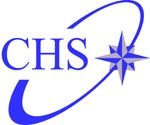 Engineering Status
Engineering Status
During Mr Jones’ time at the school, it gained status as an Engineering Specialist school (2004), continuing and building upon the school’s longstanding excellence in this area.
The school’s most famous former student also attended CHS during this time, a young Dan Sturridge was trying to keep up with his studies whilst nurturing his growing footballing career. He was signed by Manchester City’s youth academy and played for various England Youth teams during his time at CHS. Here he is with his Year 9 team mates in 2004.
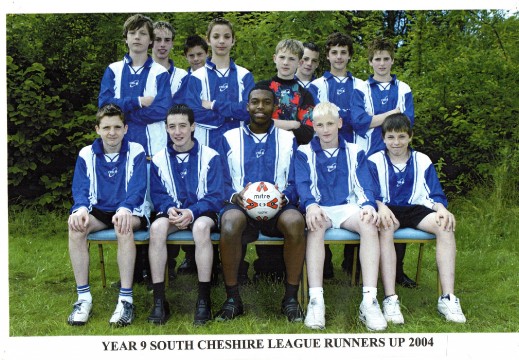
Current Executive Principal Mr Hermitt remembers him well: “We are incredibly proud of Dan. When he was with us, he was a very smart, very polite student who got on with his studies and was very popular with is peers. He thoroughly deserves all the success he has had.”
Academy status and Congleton Multi-Academy Trust
Mr Hermitt, took over at the helm in 2005 and has guided the school through an era of rapid change. Under his leadership exam results have continually improved and the school has moved through Foundation status to becoming an Academy (in 2011) and most recently conversion to a Multi-Academy Trust in February this year. He explained his vision for the school:”I want us to make a difference to a child’s learning journey right from nursery through to tertiary education, to make it a seamless journey where we provide education for that child for 18 years, maintaining relationships that extend across the years and bridge across the transition points. I believe that our geographical mini-academy chain will improve educational outcomes for children in Congleton.” He added “I also want all of our students to gain the right skills for employment; skills like resilience, teamwork, problem solving and having a can-do attitude.”
One of the most striking changes of recent years has been to the look and feel of the school buildings. The exterior of the front of the school has changed almost beyond recognition in the last couple of years due to a series of ongoing refurbishment projects, with a more modern look, a proper reception area and additional classrooms added. In addition to the exterior facelift, there have been positive changes to the internal environment of the school, with improved insulation, double glazed windows in the main teaching block, new toilets, an improved student reception and improved security with an electronic visitor signing in system.
Sixth Form Centre
Mr Hermitt has also overseen the building of the new Sixth Form Centre (in 2007), providing modern, light and airy accommodation for 6th formers, separate from the main school. The Centre has its own café, common room and well-equipped study room for students as well as classrooms and a state-of-the art media studio.
Mr Hermitt: “The school buildings had begun to be quite dated and not really fit for purpose. We needed more teaching space and an improved environment for our students and staff and our ongoing refurbishment and building programme has provided this. We are not finished yet; there are improvements still to be made to some of our older classrooms and exterior spaces, but we are extremely proud of our modern, well-equipped school.”
People’s impressions of the school today are very positive. When asked his impressions of CHS today, Roland Machin said “The school has more than regained the position it had in the late 1990s of being an outstanding school. It has responded positively to a great deal of change and it is a good sign that so many staff have been here so long.”
Continuity
What is obvious from the pulling together of these memories of the three schools is that there has been so much continuity. There have been a lot of long-serving members of staff and the school has also seen generations of the same families attending through the years. Deputy Principal, Mr Barlow, who has been at the school since 1993 commented: “Even now, when we have events like our Open Evening, parents who have brought their Year 5 or 6 children to look around the school come and speak to me because I taught them when they were at the school, and often their parents came here as well.”
Paul Sumnall's family have had 3 generations attending the school. He wrote to us to tell us that "My father, Stephen Sumnall, along with his friend at the time were in fact the first two students to arrive on that first day 50 years ago! They both cycled there from their homes in Bromley Farm, leaving home early to make sure they got there in time." Mr Sumnall himself attended the school when it was Heathfield High and he "fully loved every day there having many laughs and making hundreds of friends over the 5 years." His daughter, Emily is currently at CHS and she will be hoping to bring her grandfather along to the celebrations on 20th June.
Engineering
Another thread that has been running through the school since its inception is Engineering. Although a lot of engineering companies in this area have now gone, the school still has links with companies like Bentley Motors, who at one time took boys from the school as apprentices. Today the school still has students who successfully gain places on the Bentley apprentice programmes. One former student, Jenna Pearce, left CHS in 2009 to study Mathematics at the University of Cambridge, where she was sponsored by Bentley Motors. She graduated with a first class degree and went on to work as a buyer for Bentley on their Graduate Scheme. In May 2013 Jenna came back to CHS to lead a Business Enterprise Day for Year 10 Business Studies students where they were set the challenging task of launching a new model Bentley. Another former student, Jessica Camm, also went on to become a Bentley Apprentice. She came back into school to talk to students about the Apprenticeship scheme, bringing with her a Bentley Continental GT.
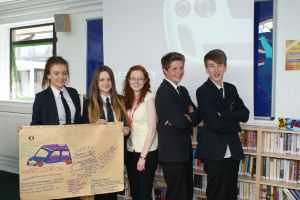
Jenna Pearce (centre) with students on the Bentley Enterprise Day April 2013
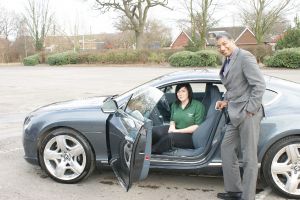
Mr Hermitt with former student Jessica Camm, admiring the Bentley Continental GT
As well as Bentley, we still work closely with other companies such as Siemens, Astra Zeneca, Airbags International, SMS Mevac and others. We are extremely proud of these links and grateful for the support of these partner companies, who are involved in providing specialist training programmes and Engineering scholarships, providing professional support for clubs and challenge events and organising competitions for students within school.
Although retired from teaching now, Bob Griffiths is still with us working in the art department, making him the current longest-serving member of staff. He started work at the Boys’ school in September 1972 so he is now in his 42nd year working here. He has taught several generations of Congleton students and has fond memories of his time here.
Lynda Arnold is another long-serving member of staff, who retired a few years ago. She loved her time teaching at Heathfield: “The staff were special. We were a family and were close as a group. Even now we are in contact on a regular basis. The students too were special in that they were very friendly and sociable but generally hard working. This is something that has always been part of the Box Lane school right from day one.” She has particularly fond memories of sporting trips and extra-curricular activities: “As a PE teacher I was very lucky to see students develop their personalities through sport and competition, share their highs and lows (and mine) and watch them develop confidence and leadership skills - this was something special. I remember just being with the students away from the school day was special. Singing on the bus, MacDonalds visit if we won, a quiet bus if we were disappointed – all fond memories. The school developed a formidable reputation for sport through the 90s and to this day it is one to be reckoned with in all sports.”
CMAT merges with KMAT
Mr Hermitt decided to retire in 2020 and this led to the merger with a local Knutsford Multi-Academy Trust from September 1st, which formed a regional trust consisting of 10 schools. This new trust was called The Learning Alliance. 
Then in September 2023, TLA merged with a trust of primary schools (The Learning For Life Partnership), to form The Learning Partnership. TLP currently consists of 15 schools across North Staffordshire and East Cheshire.

